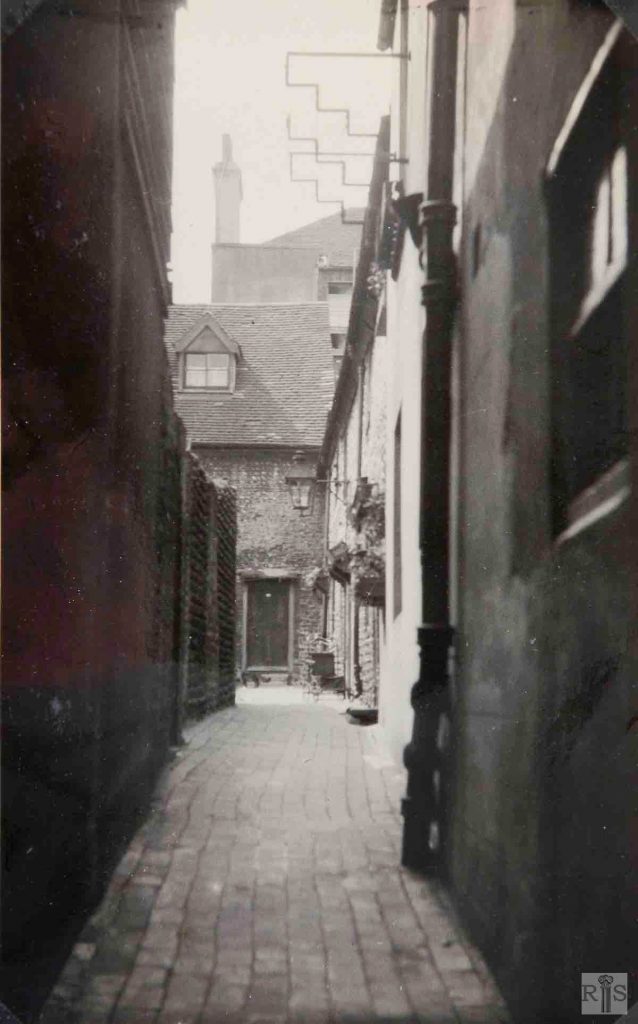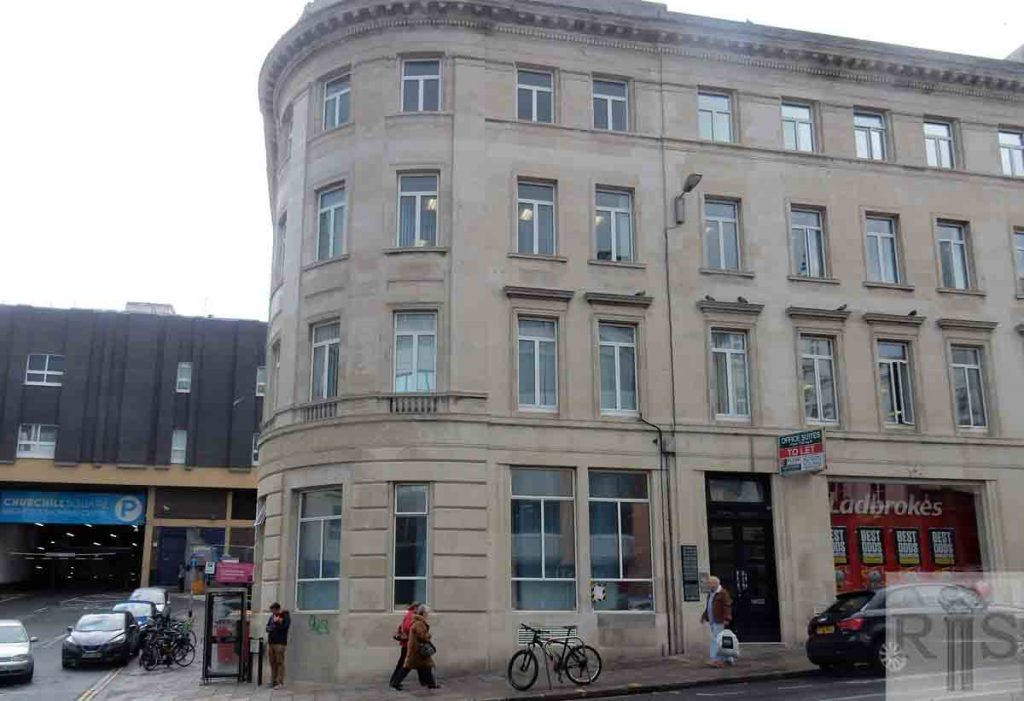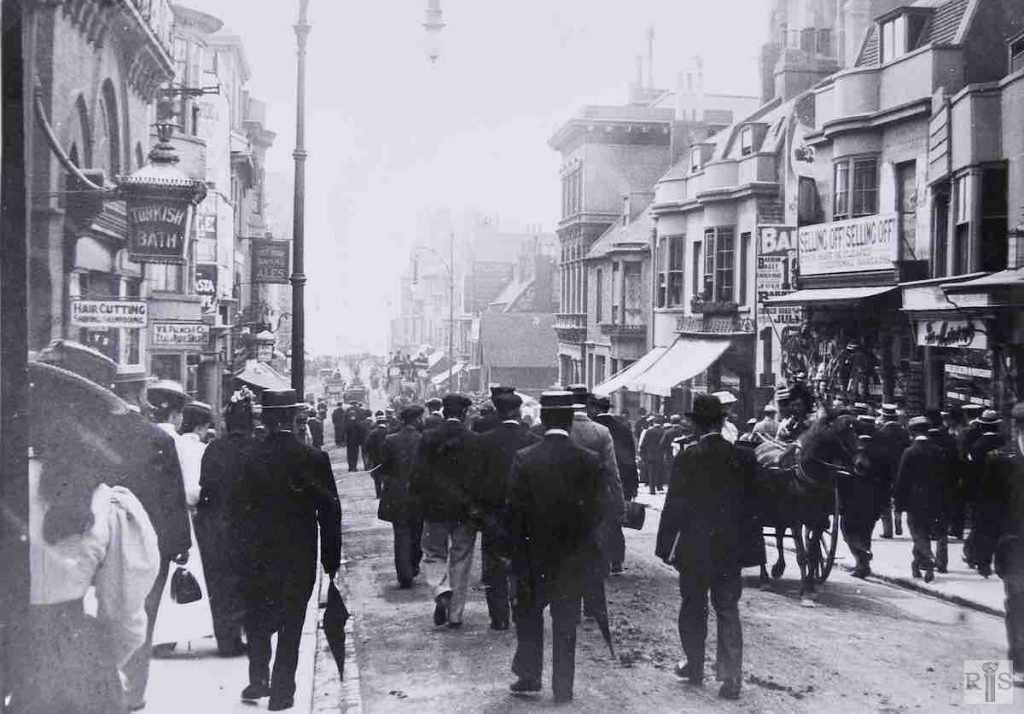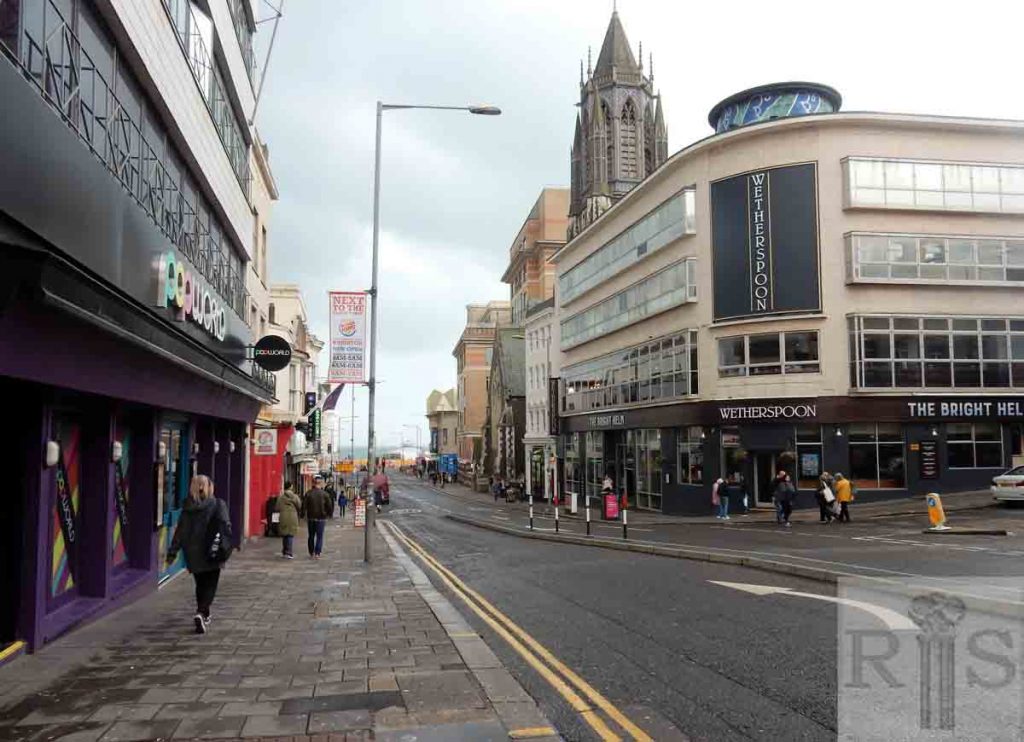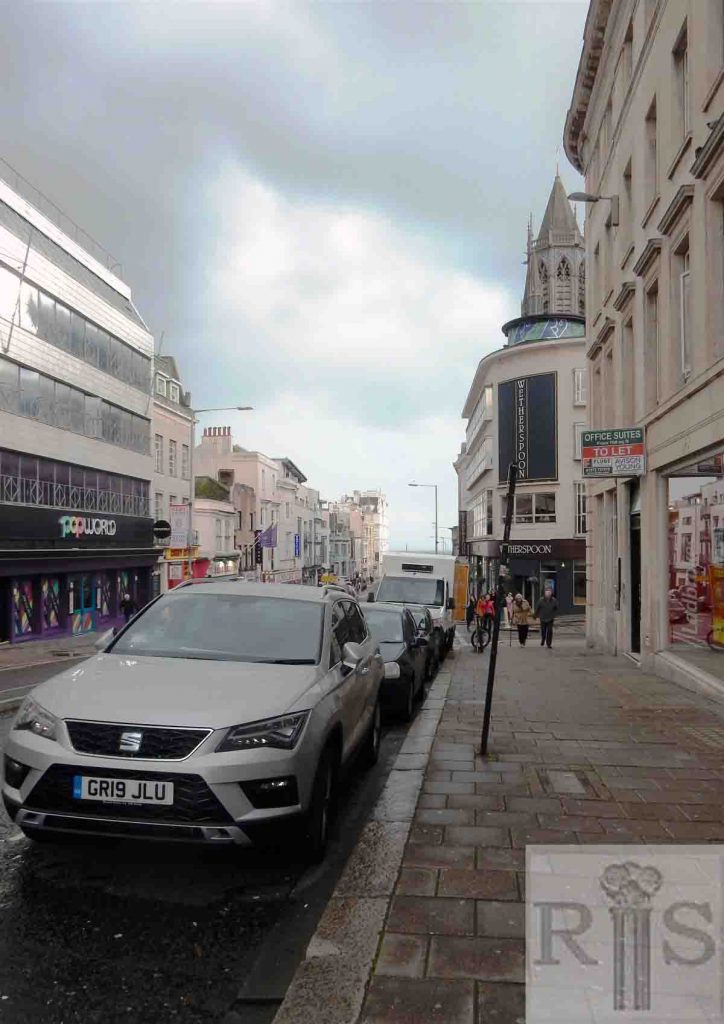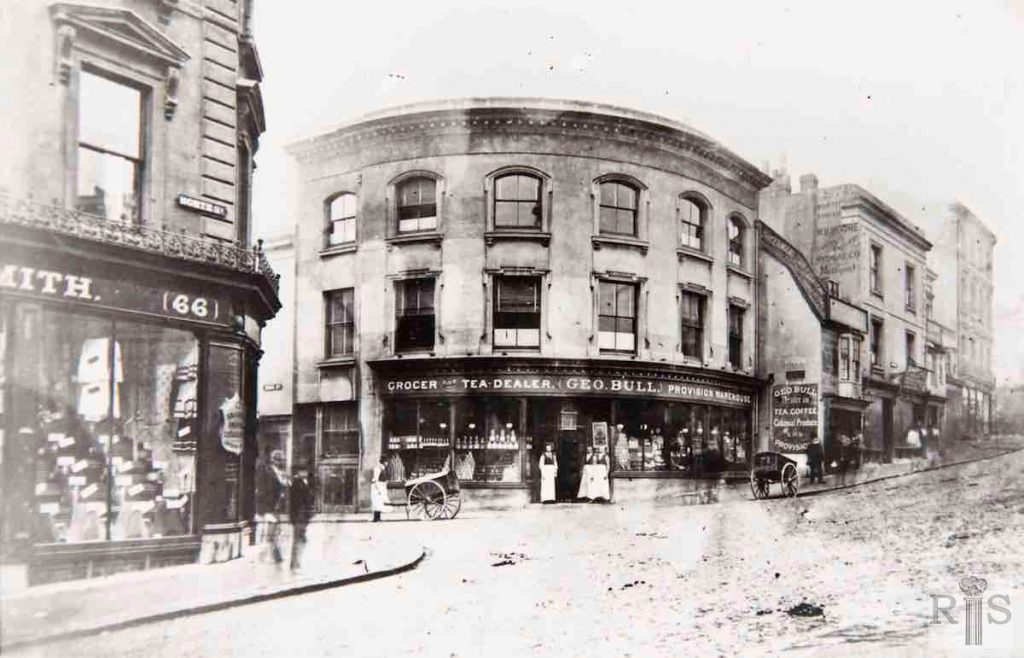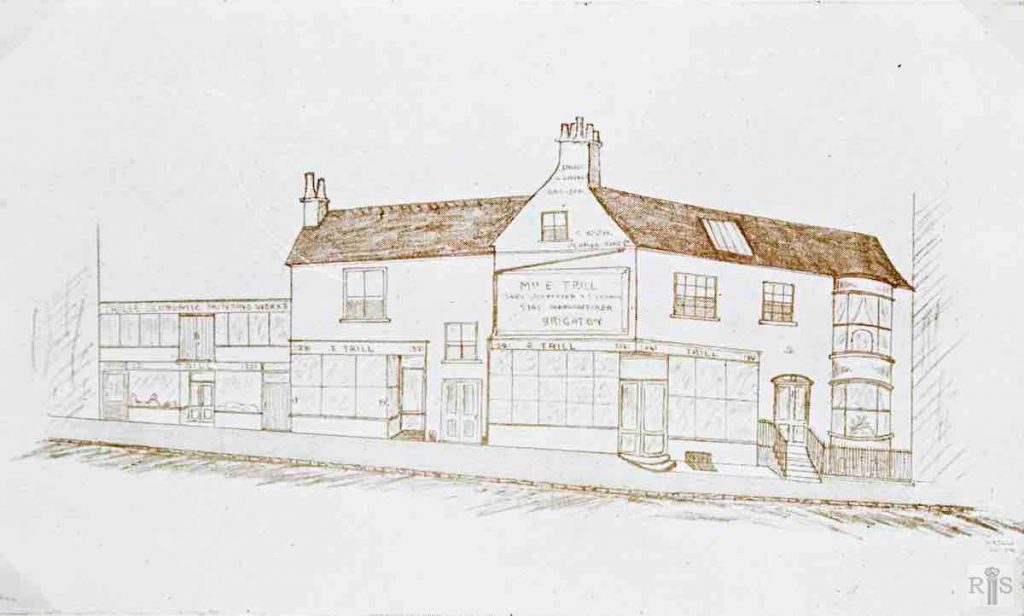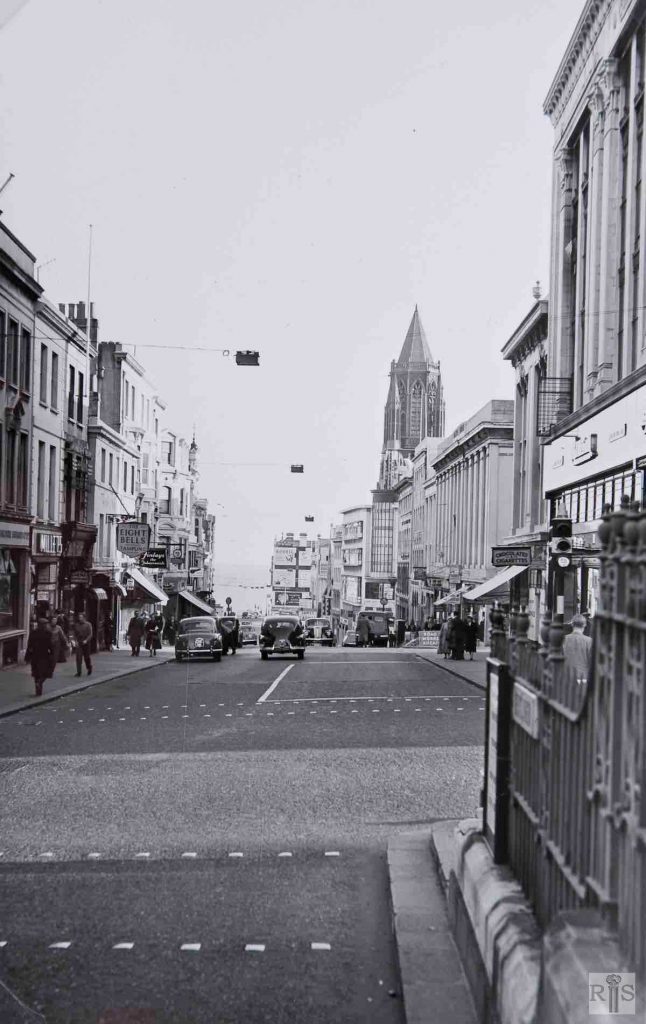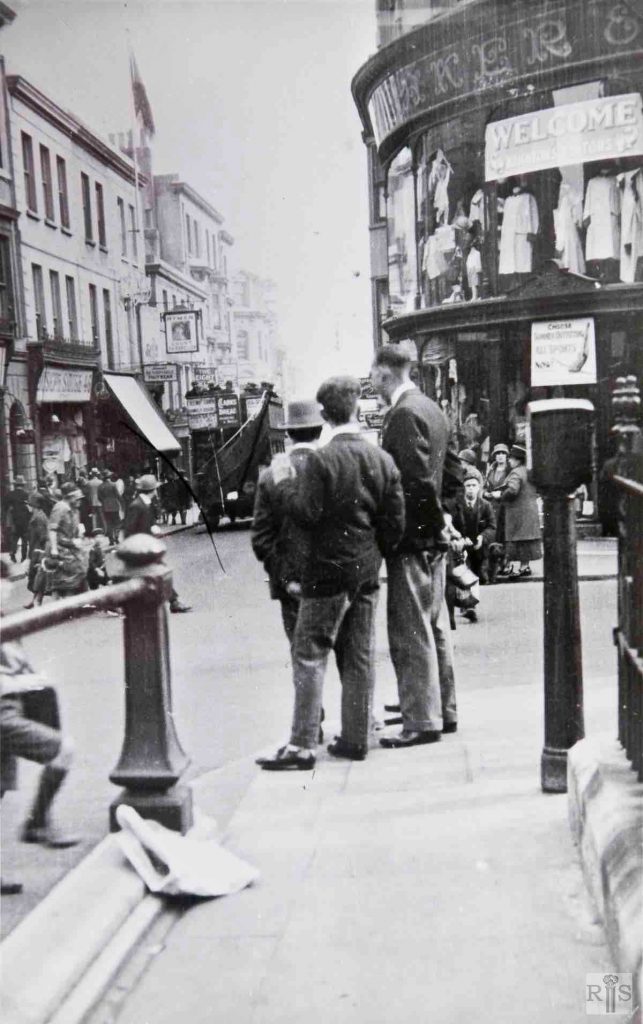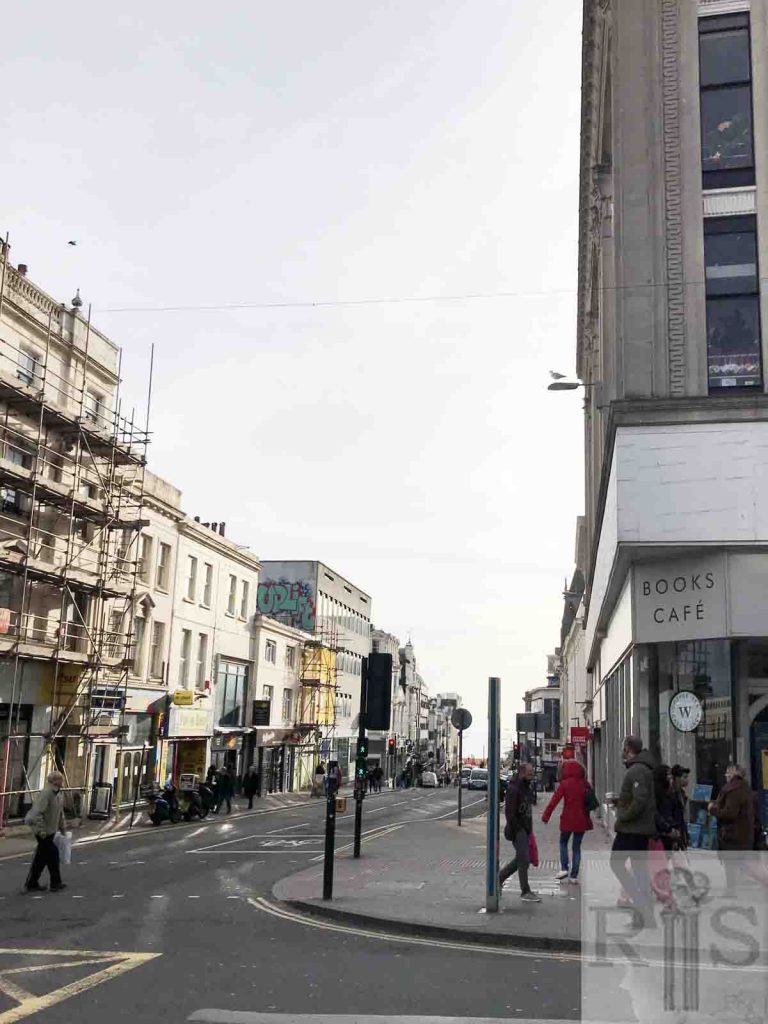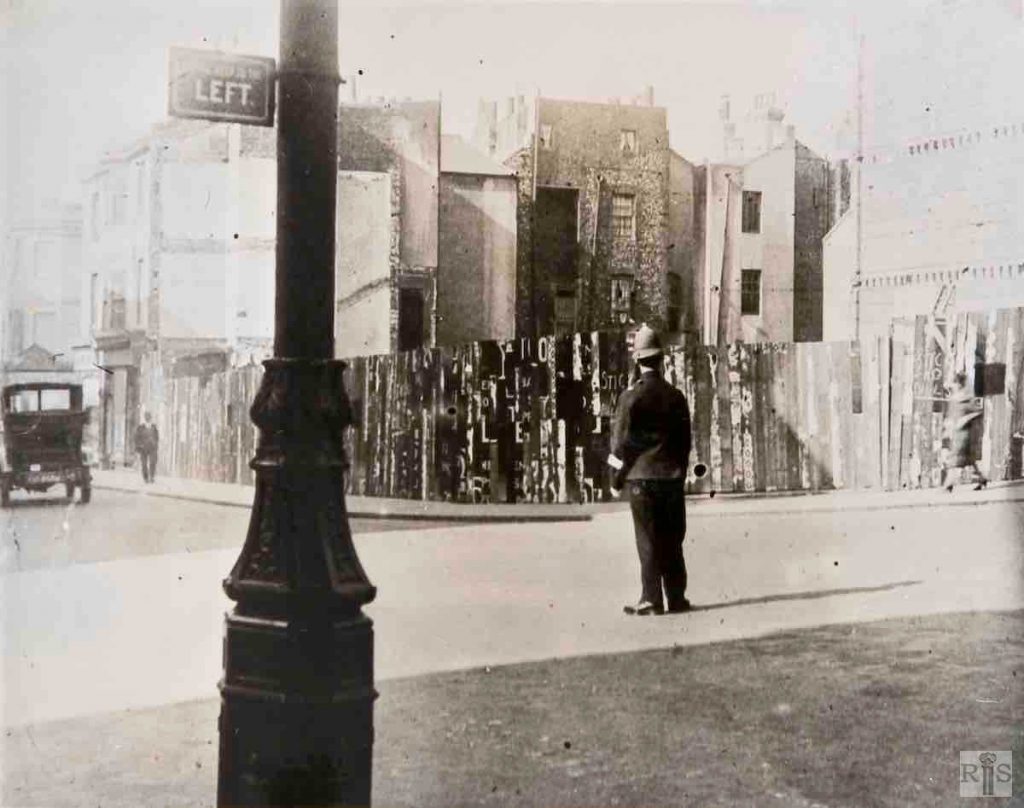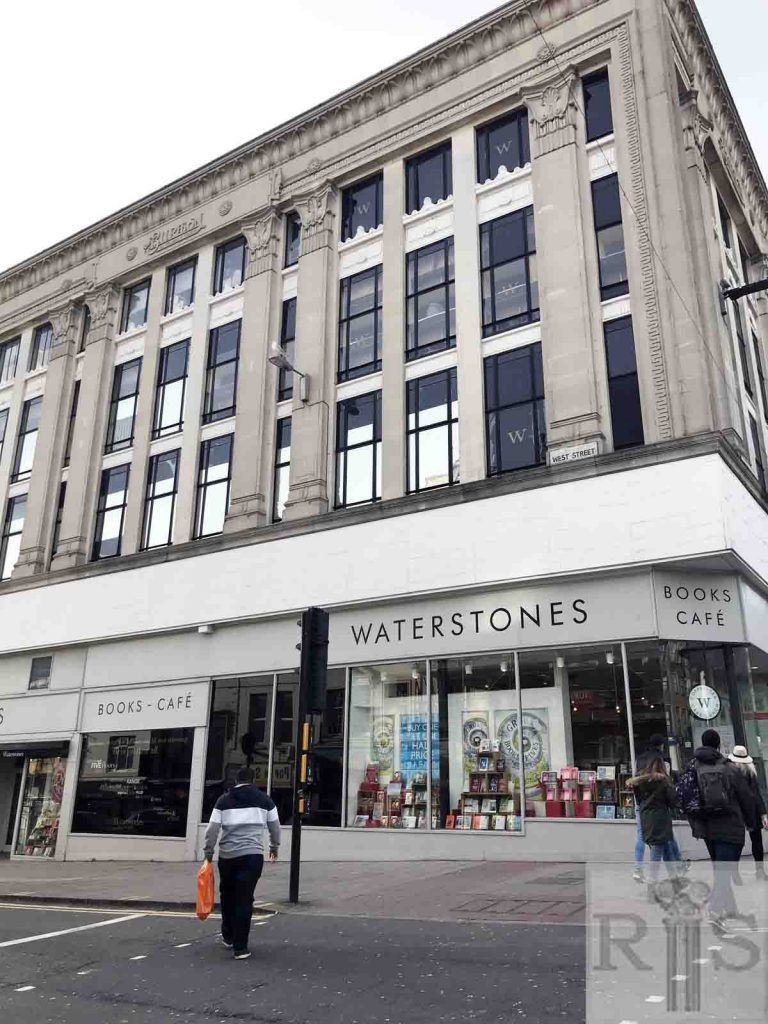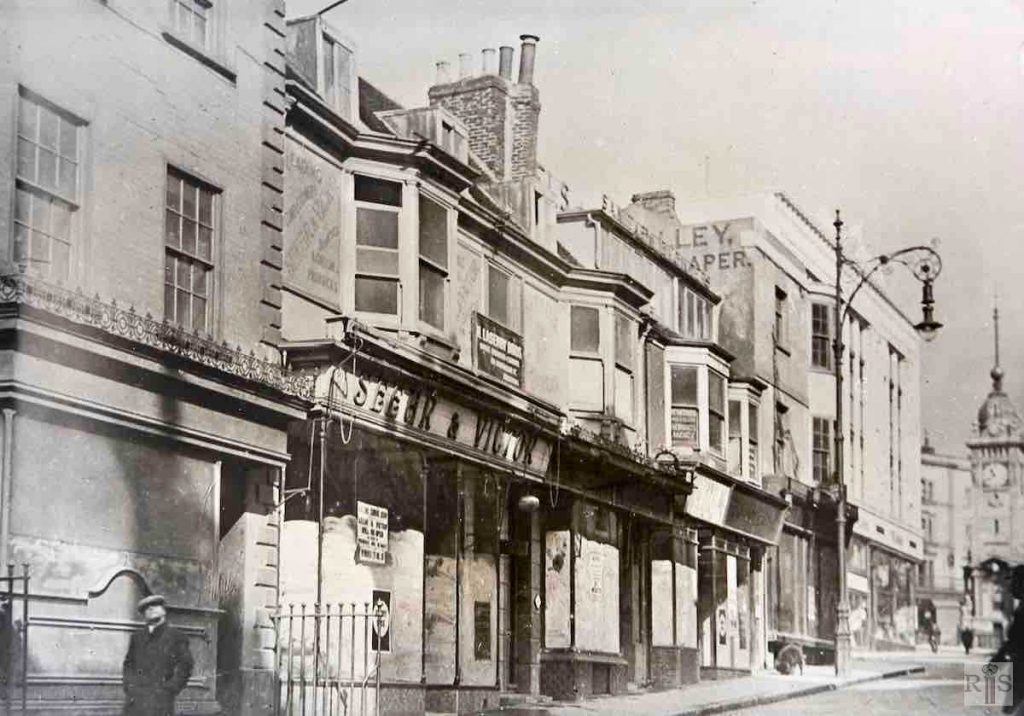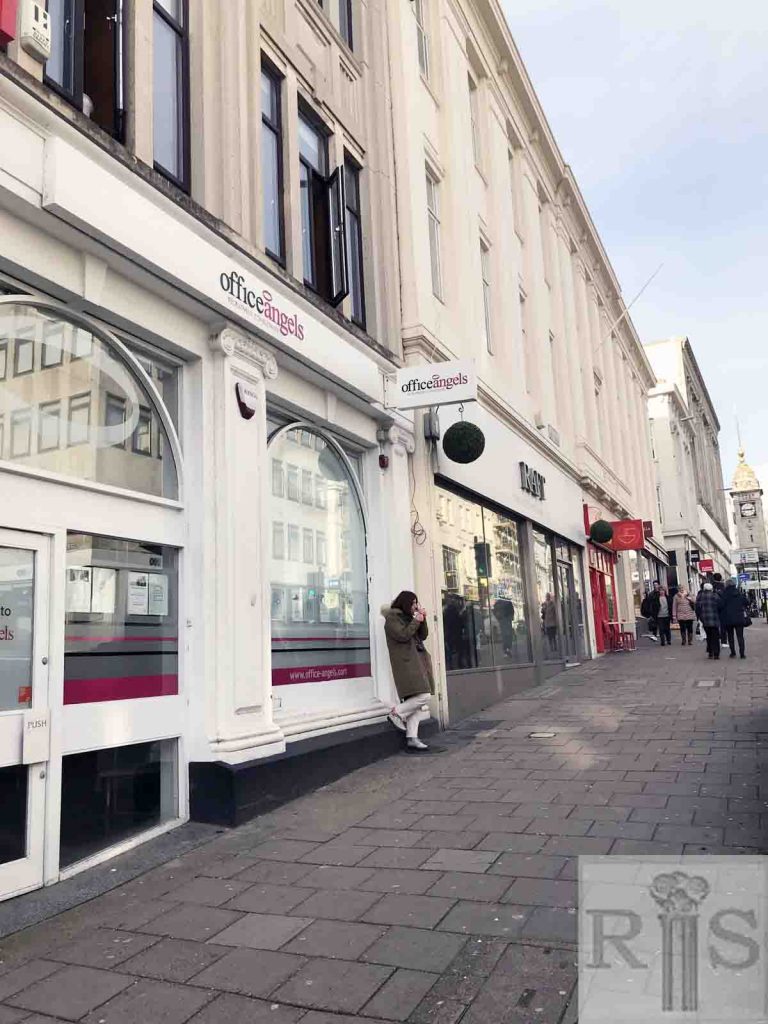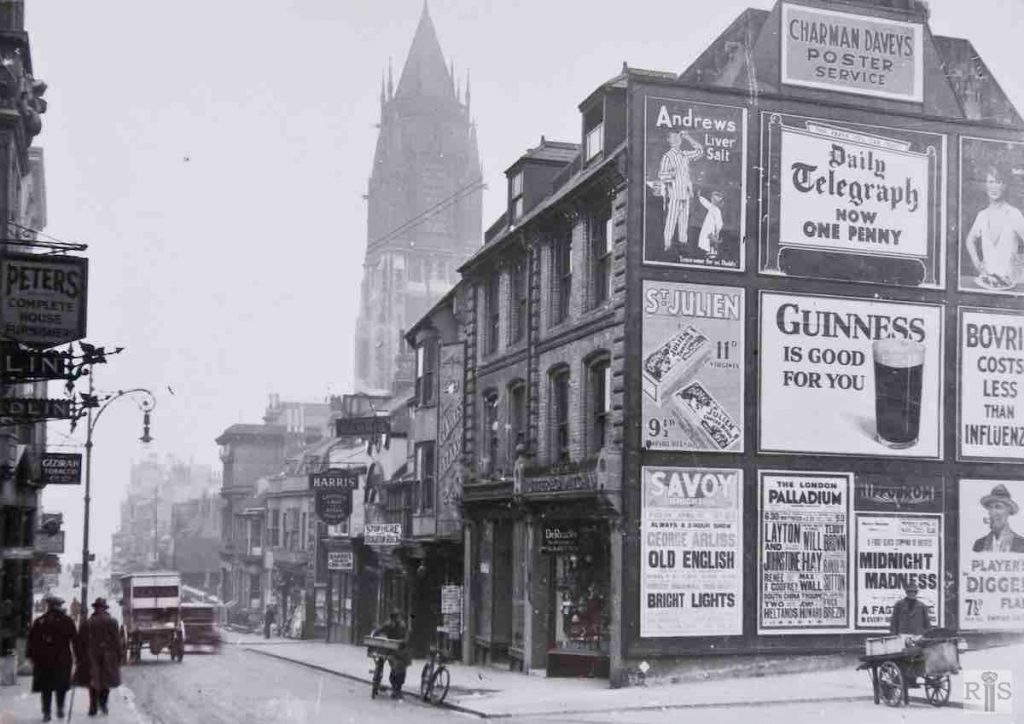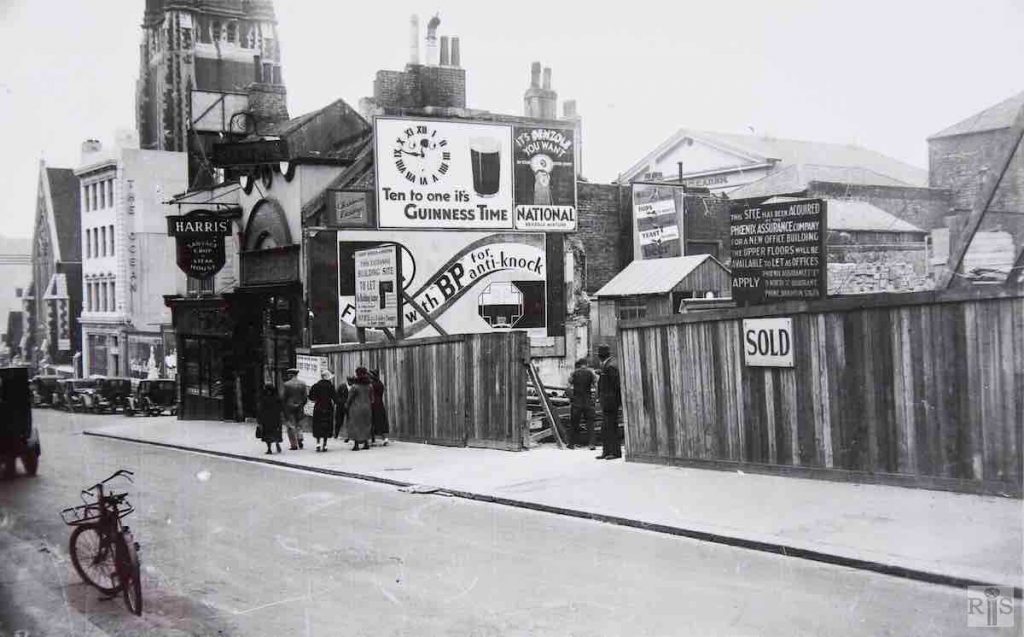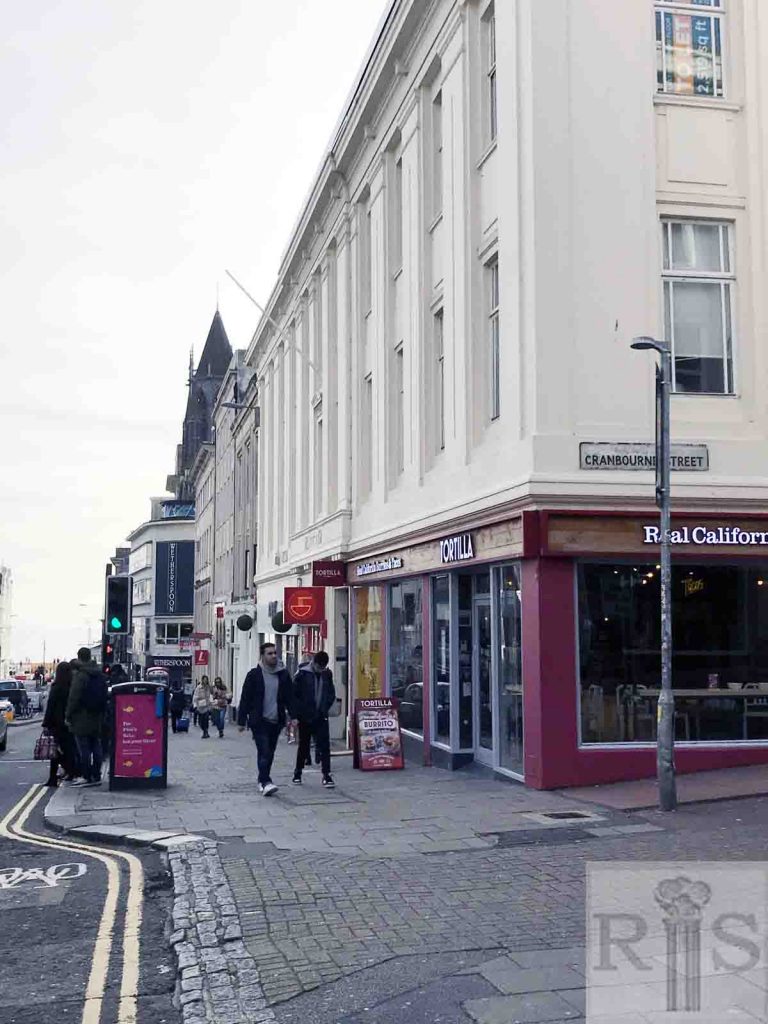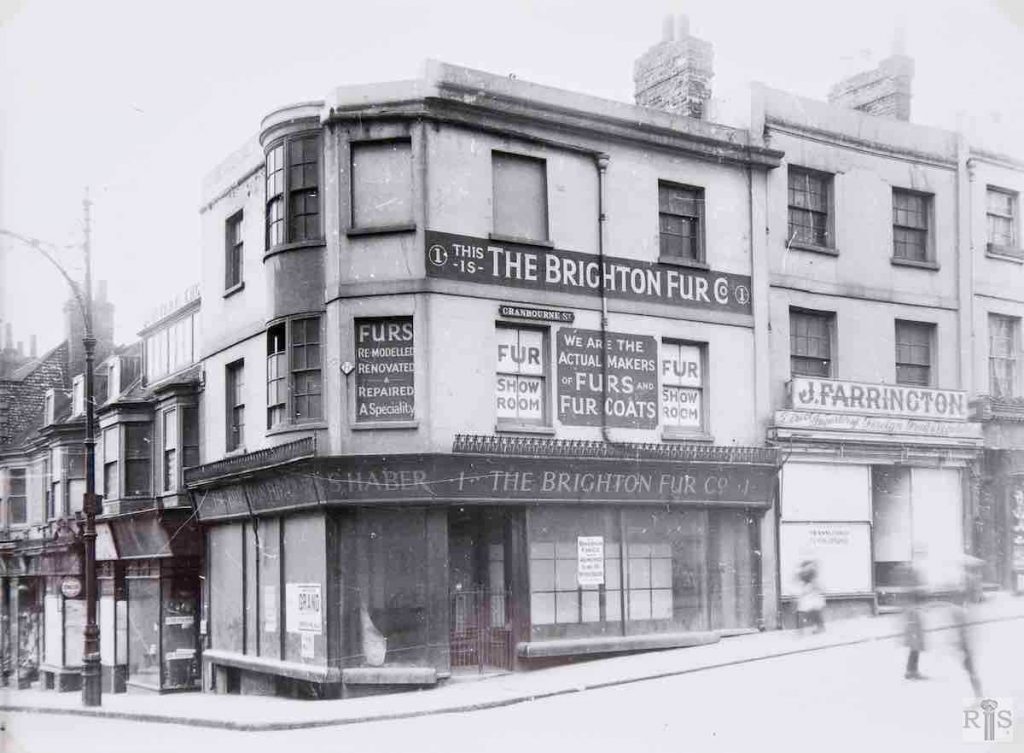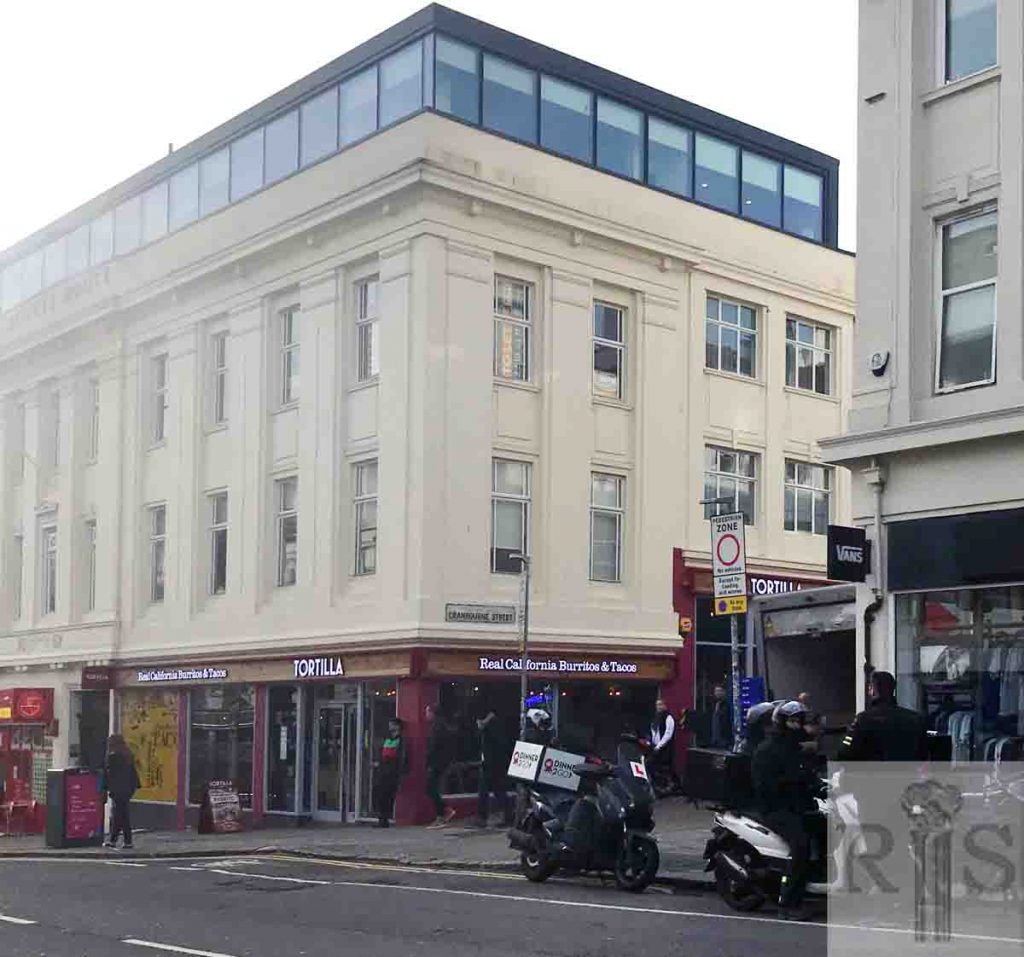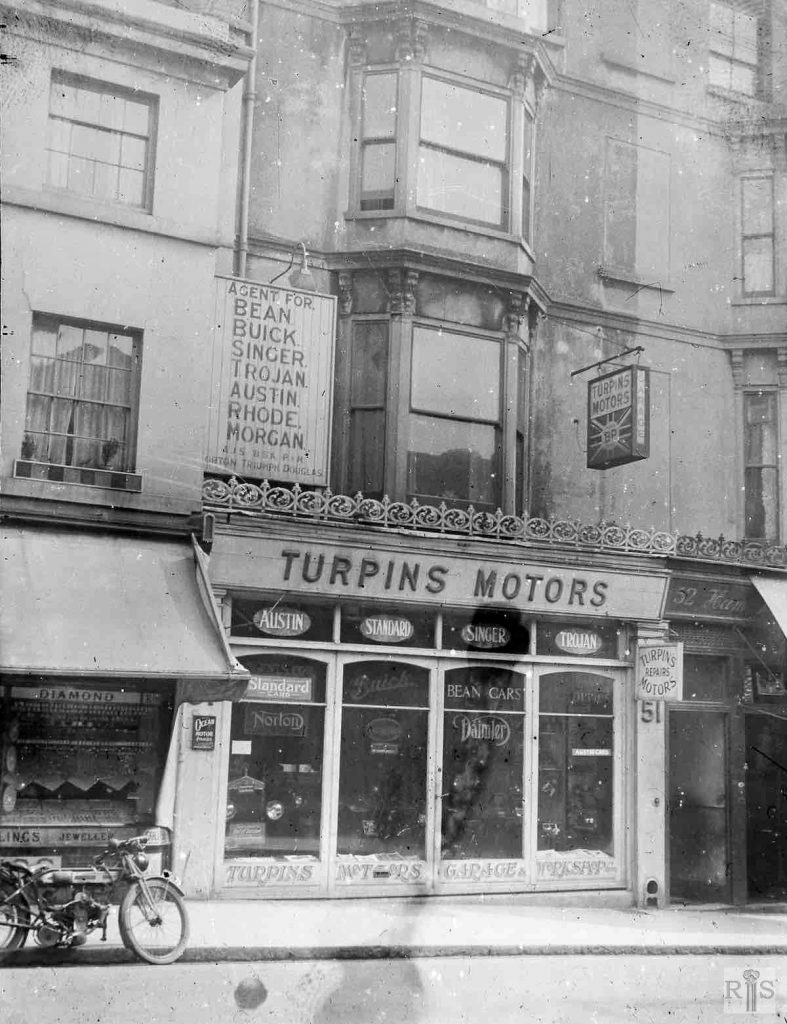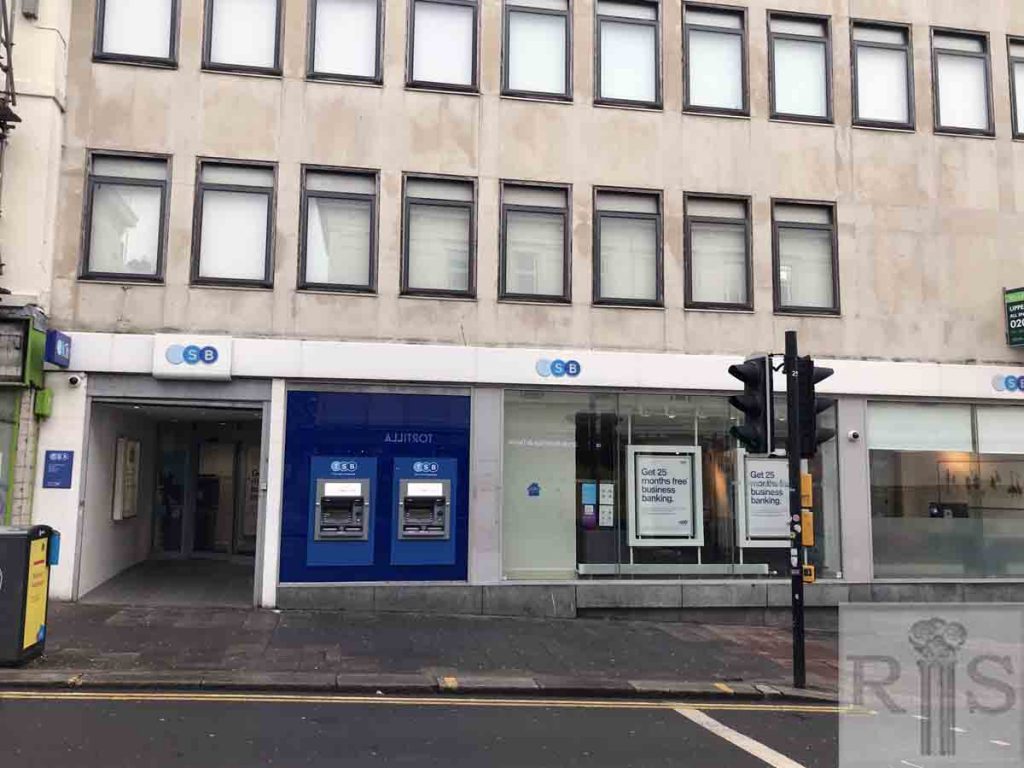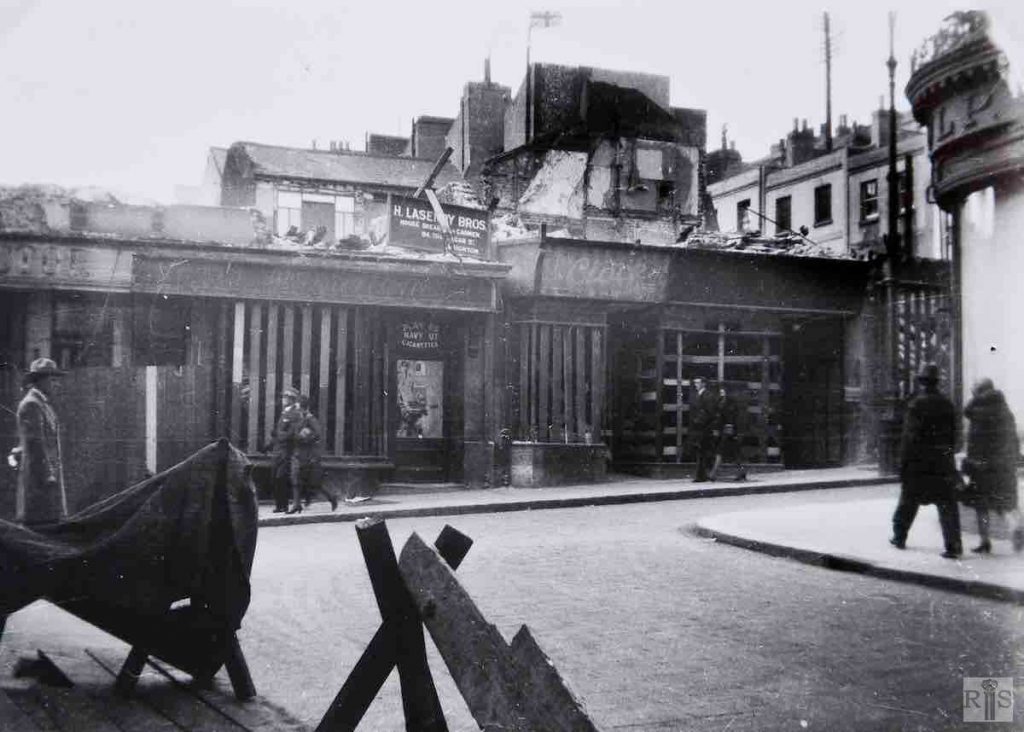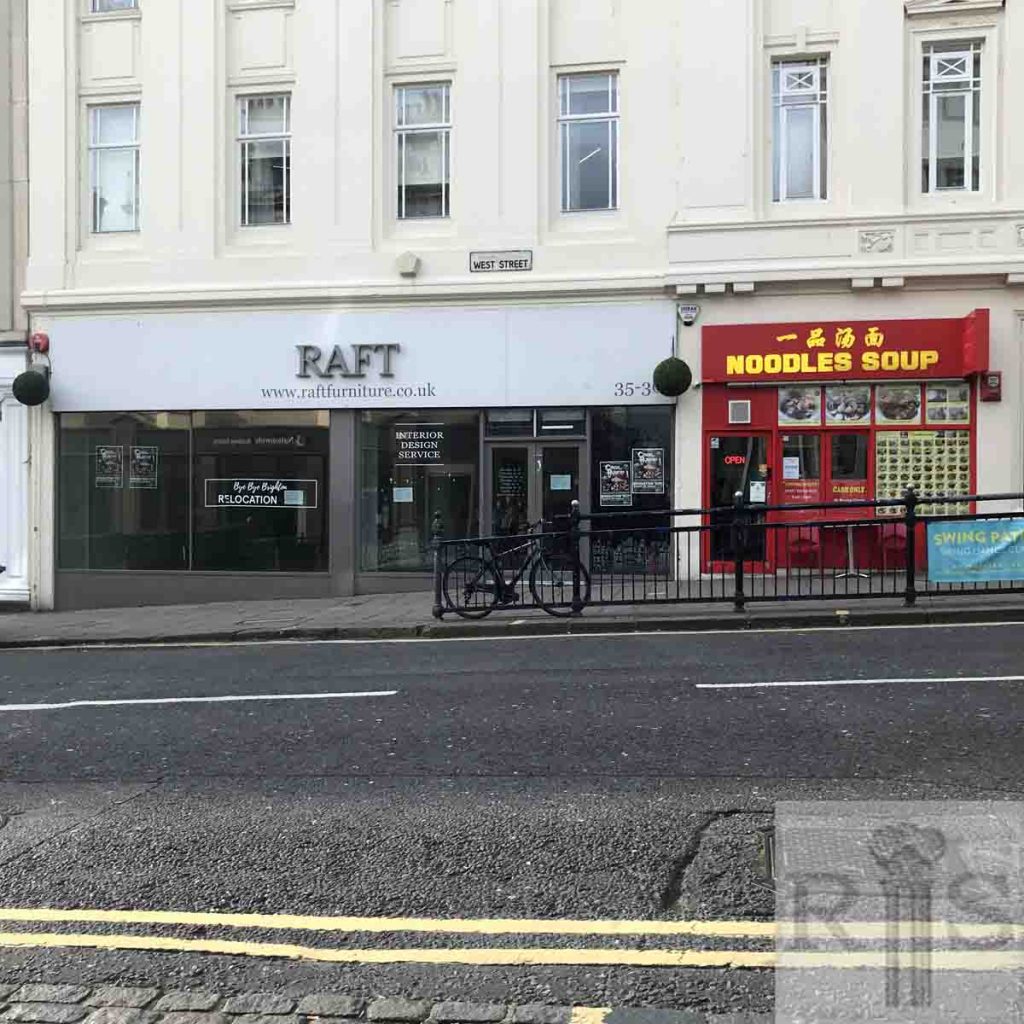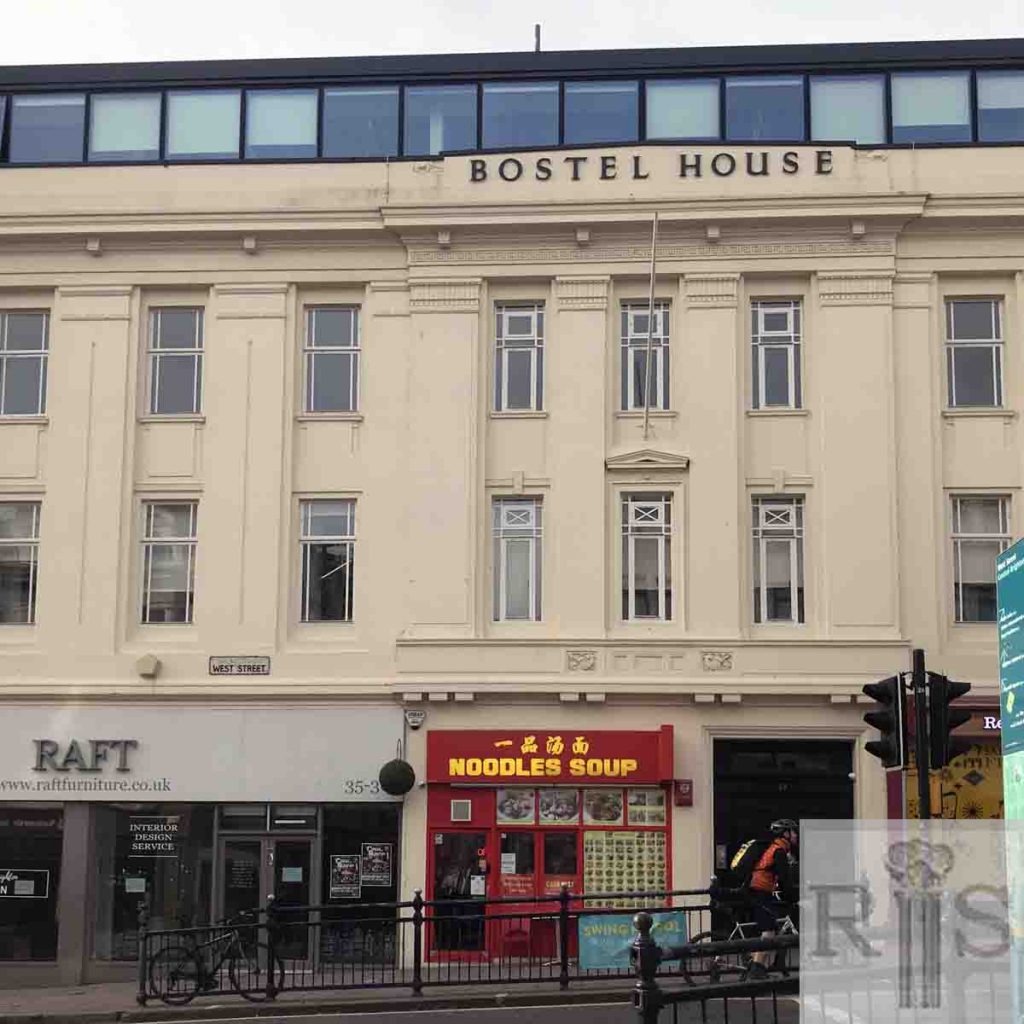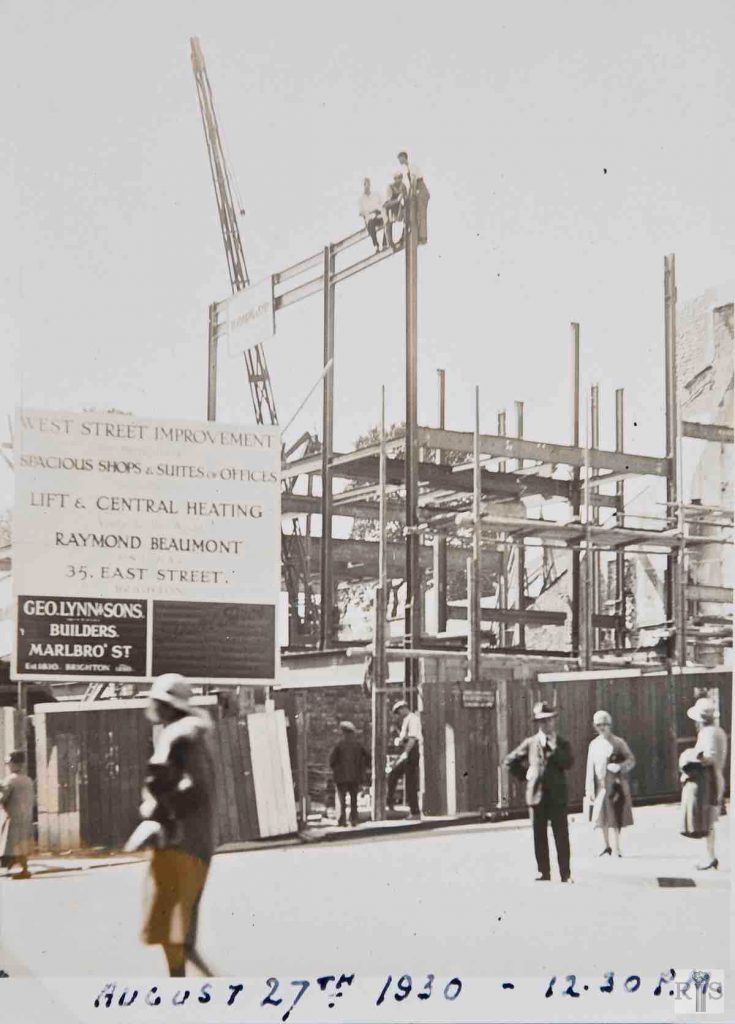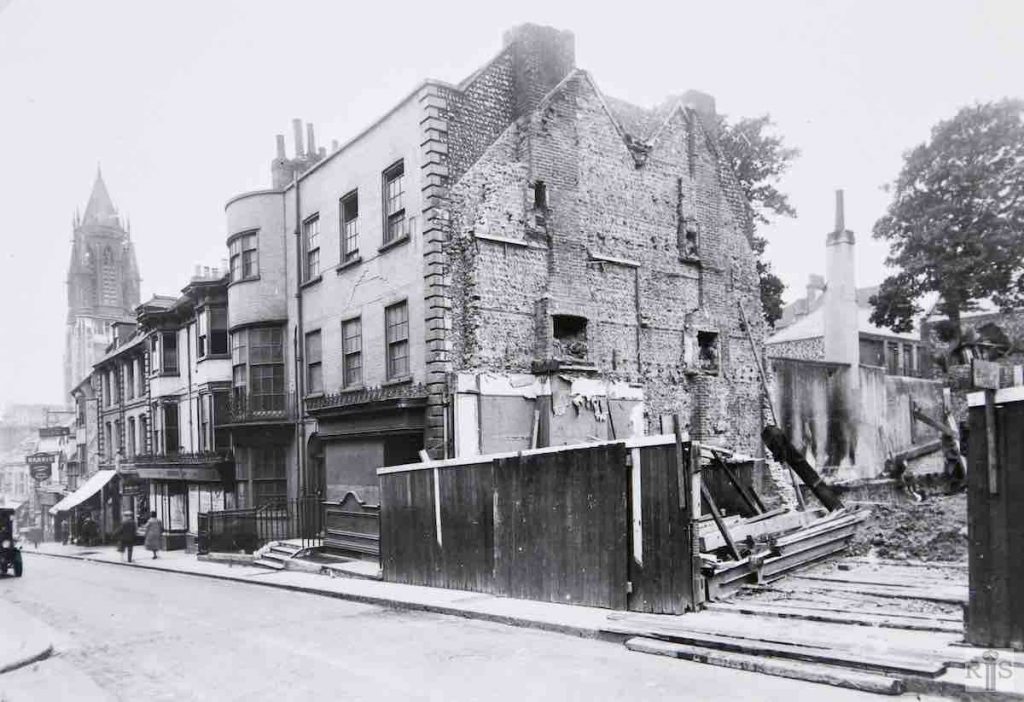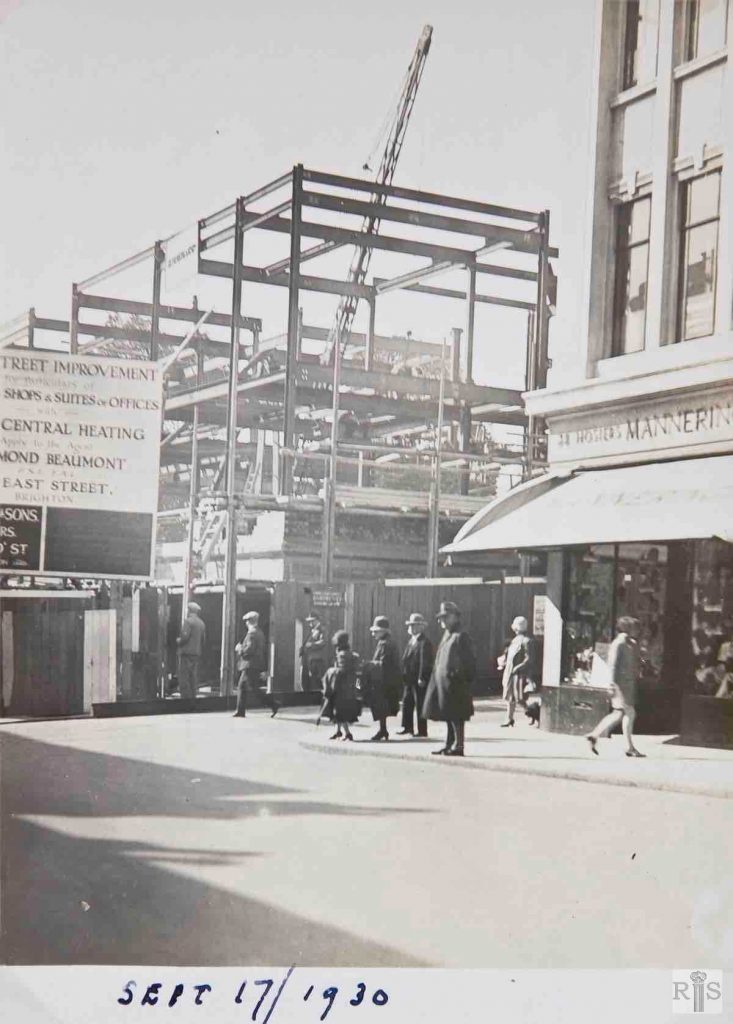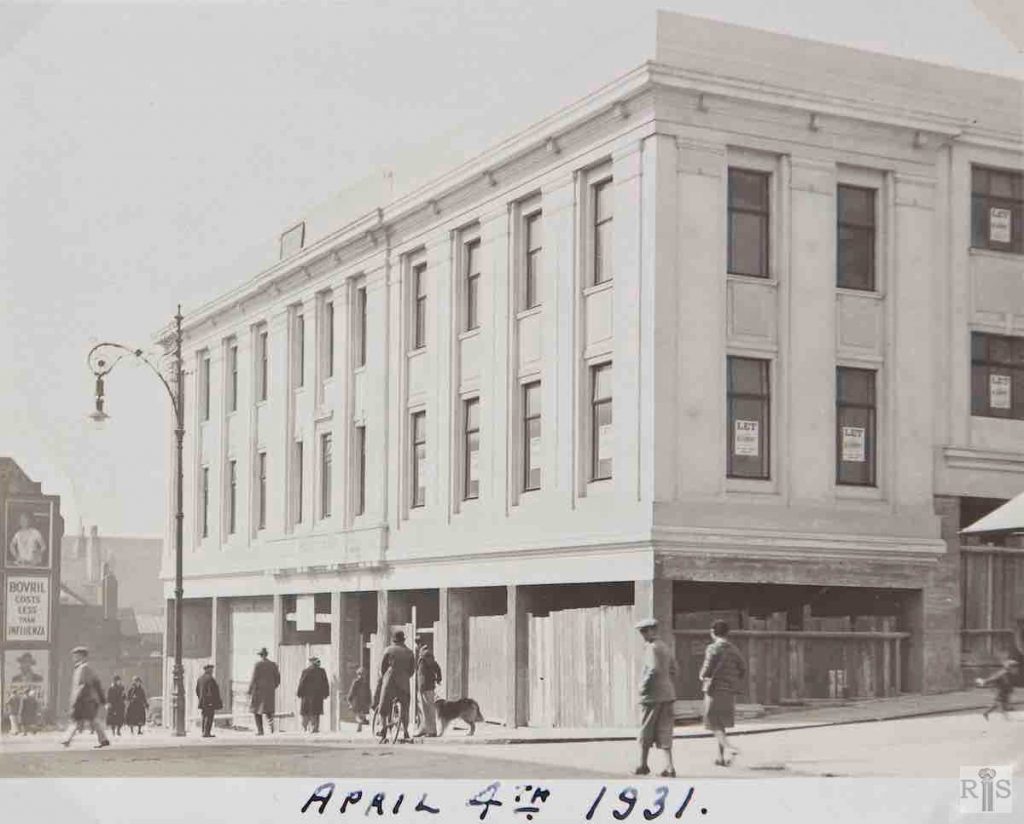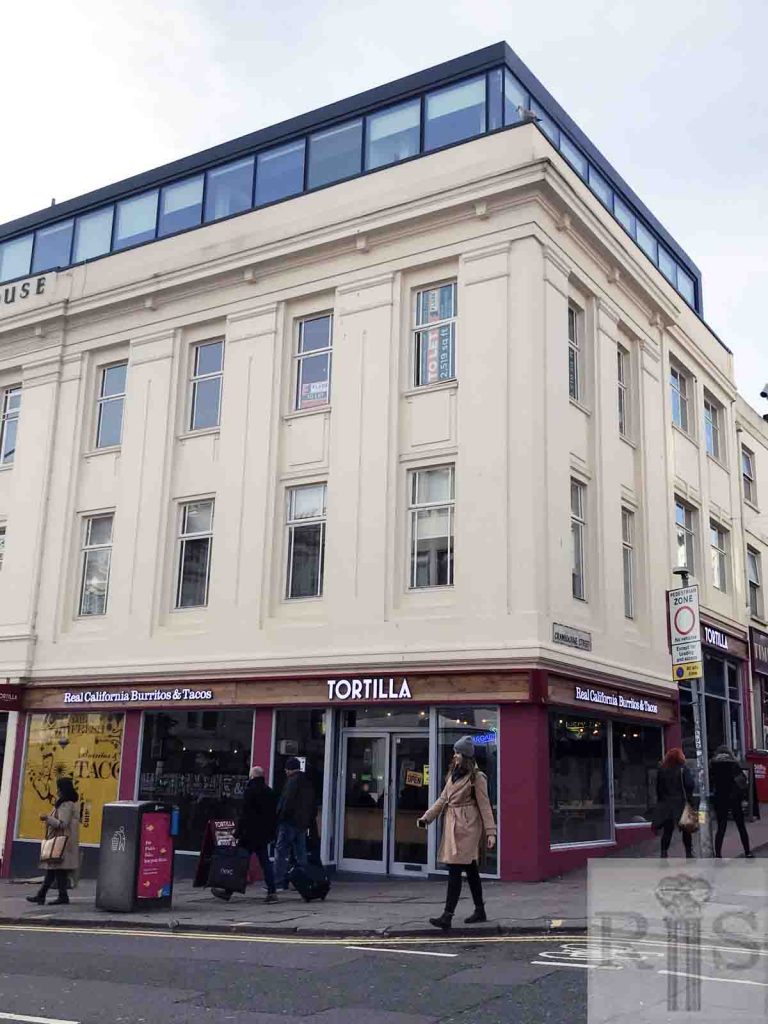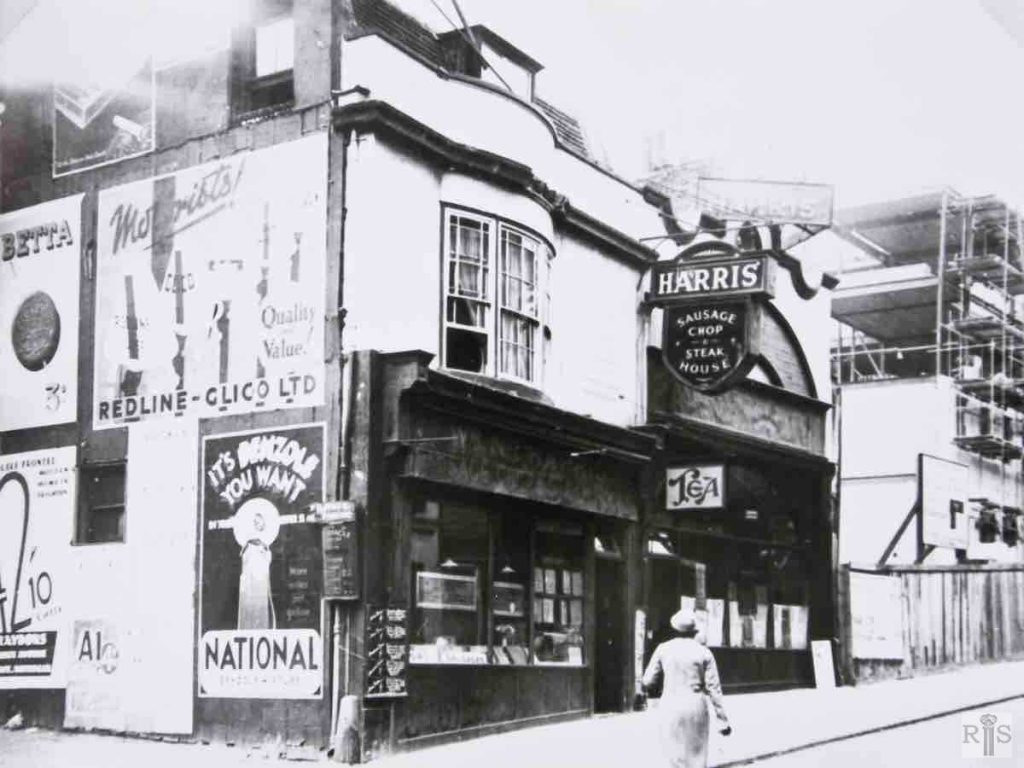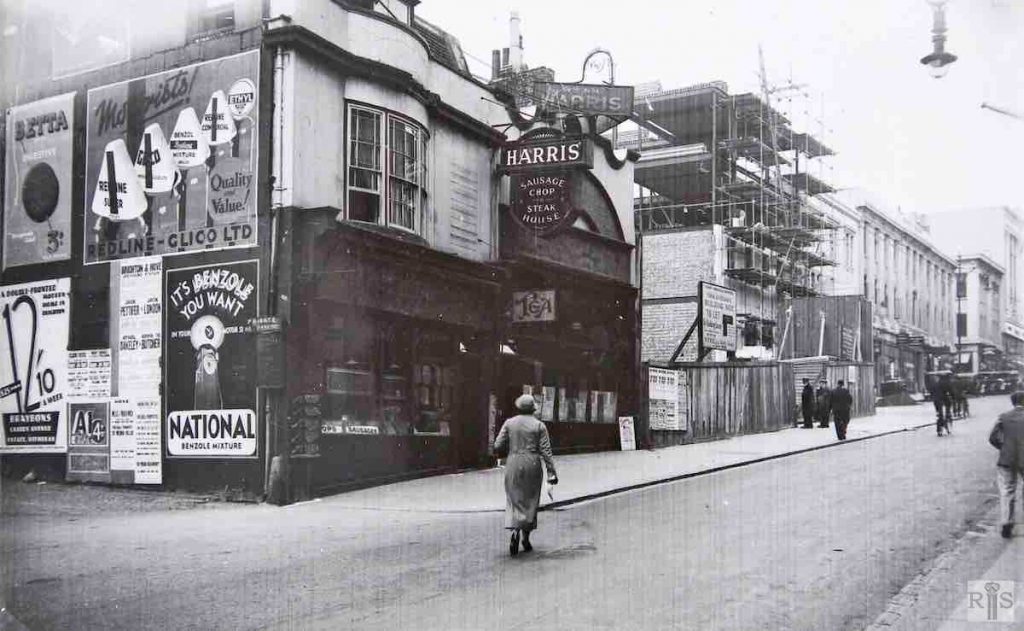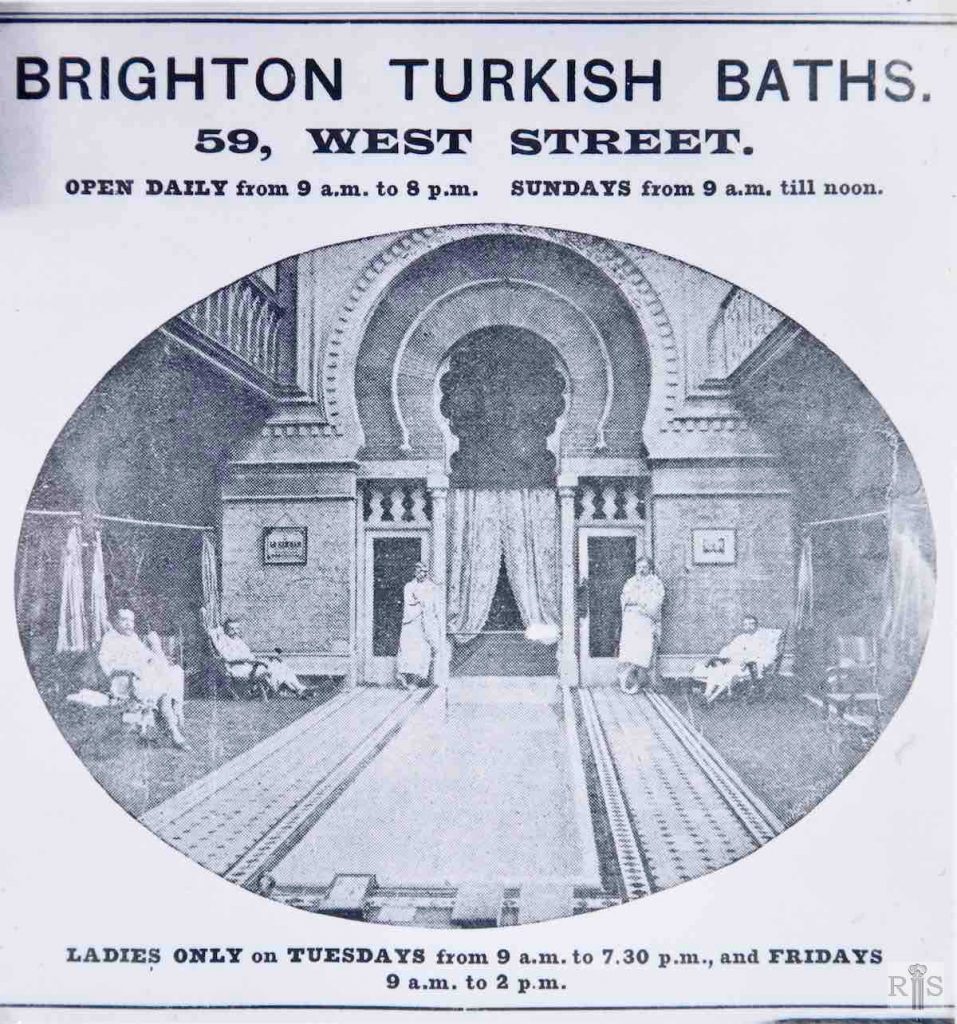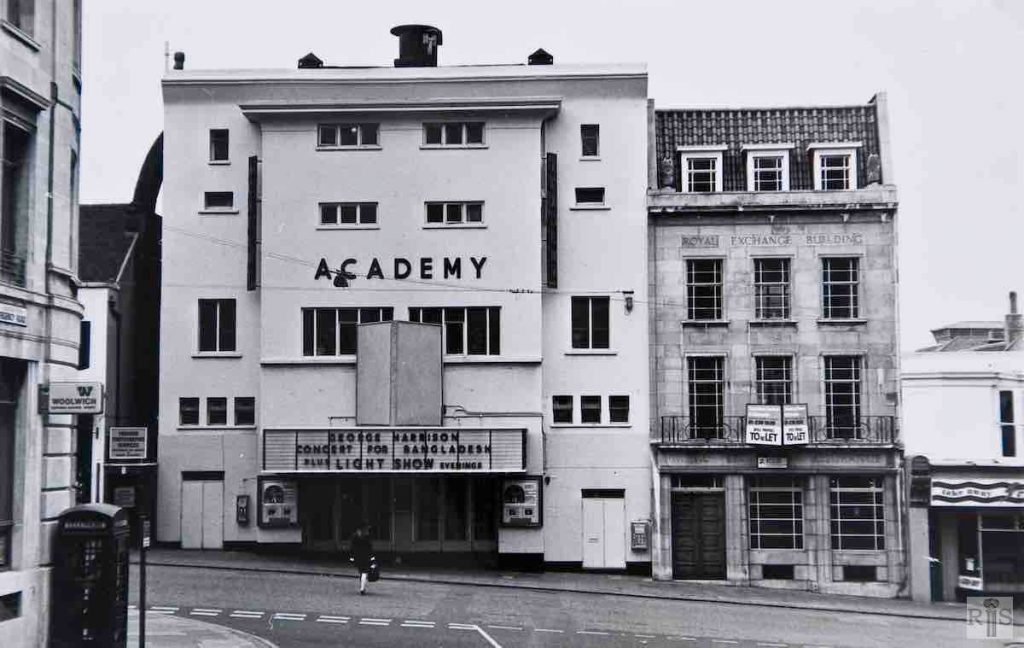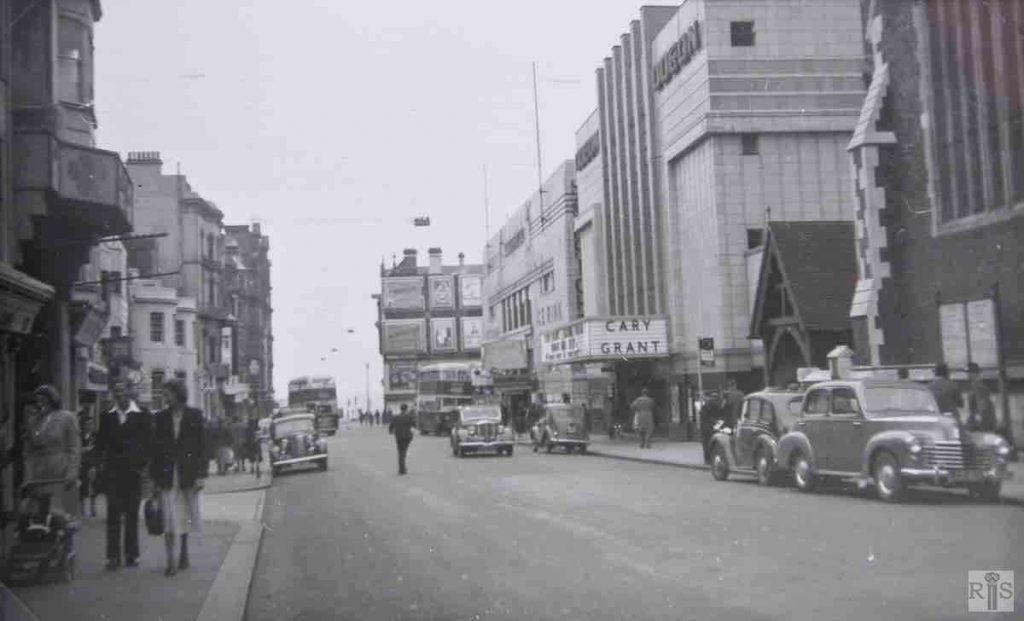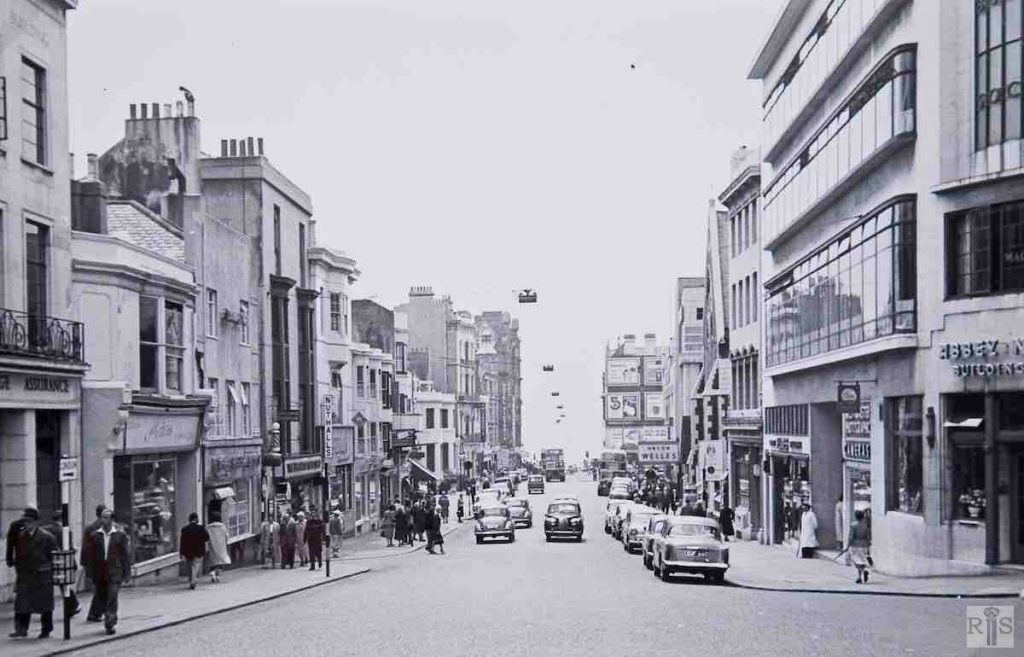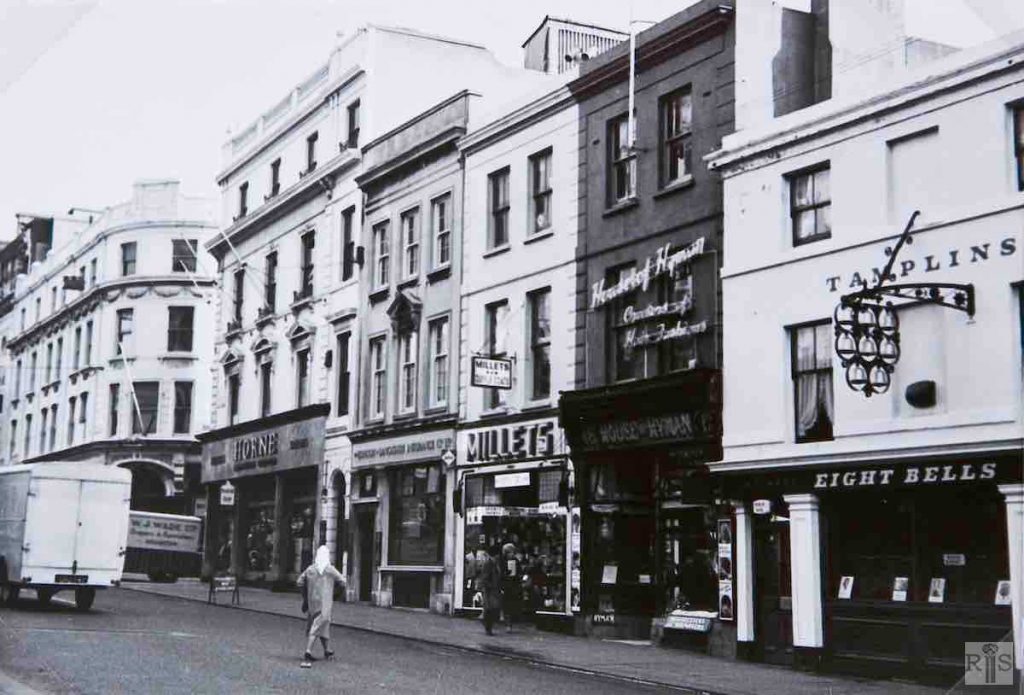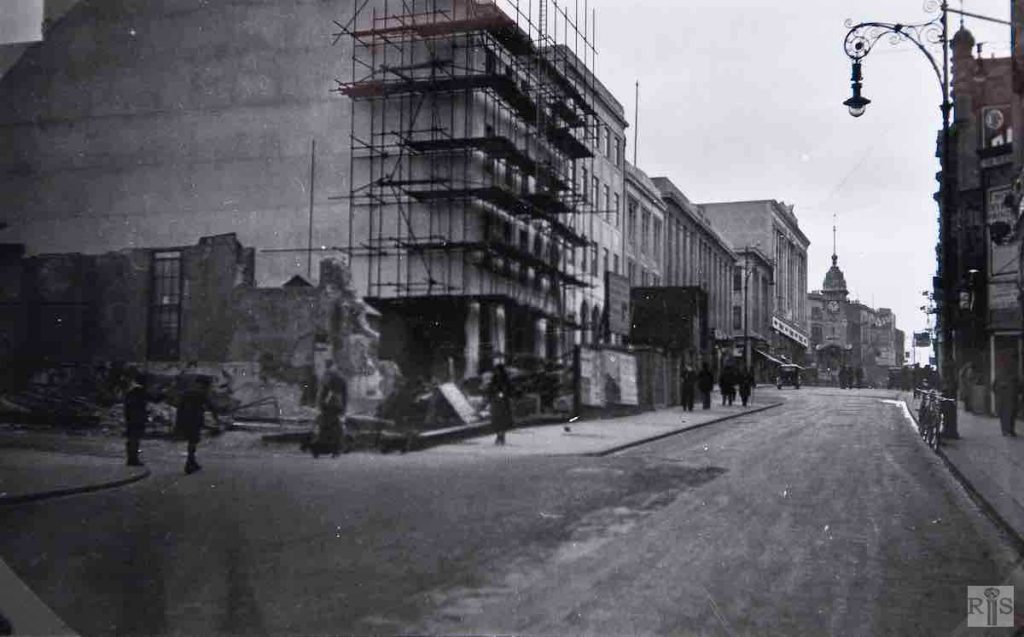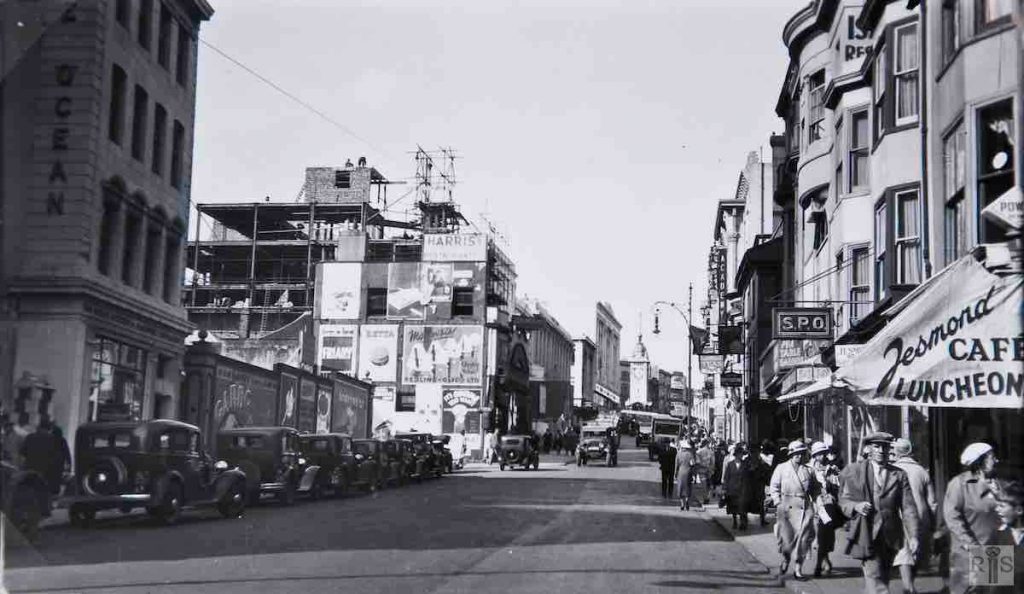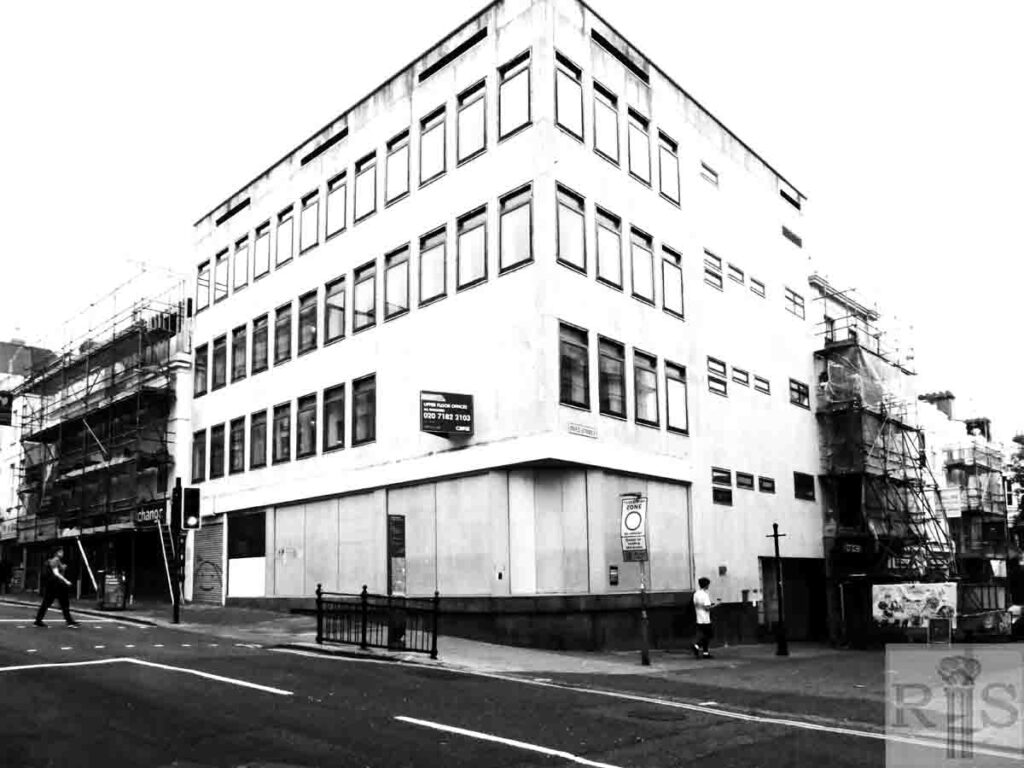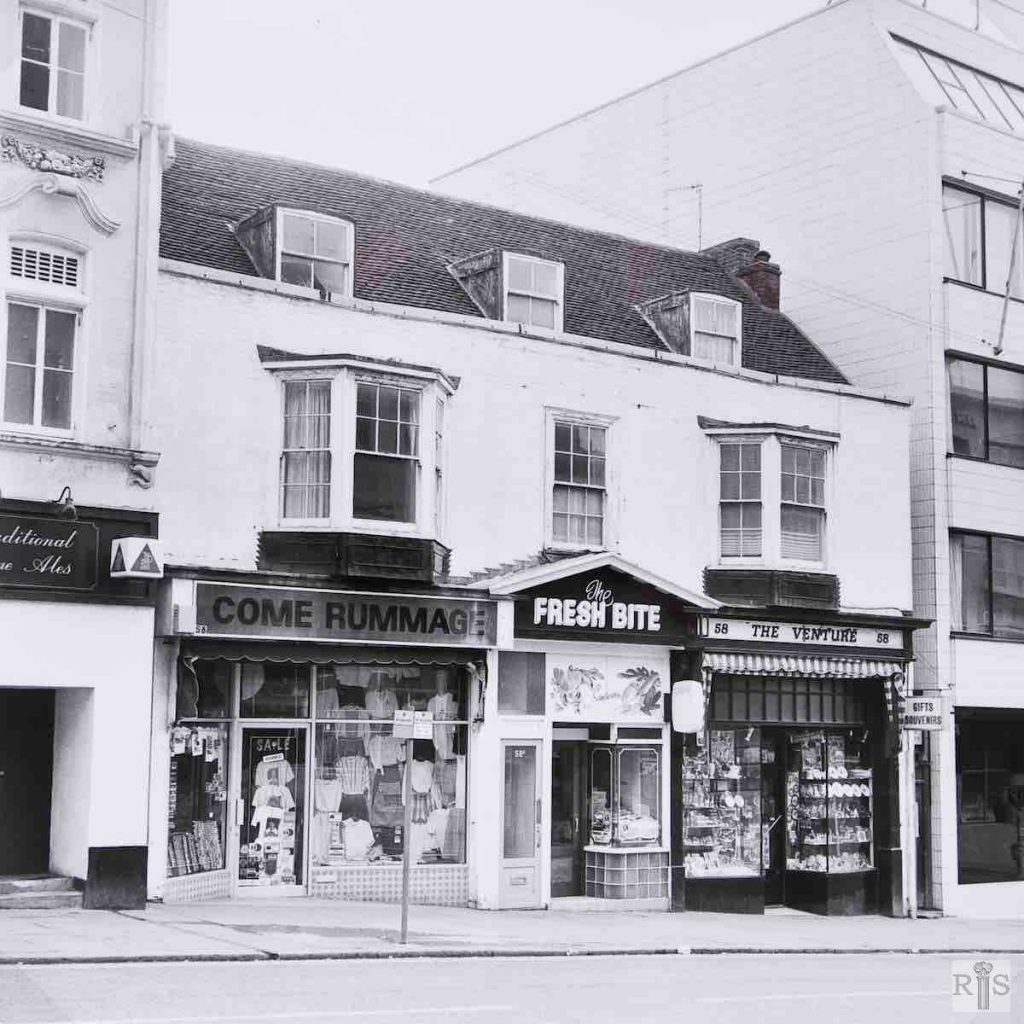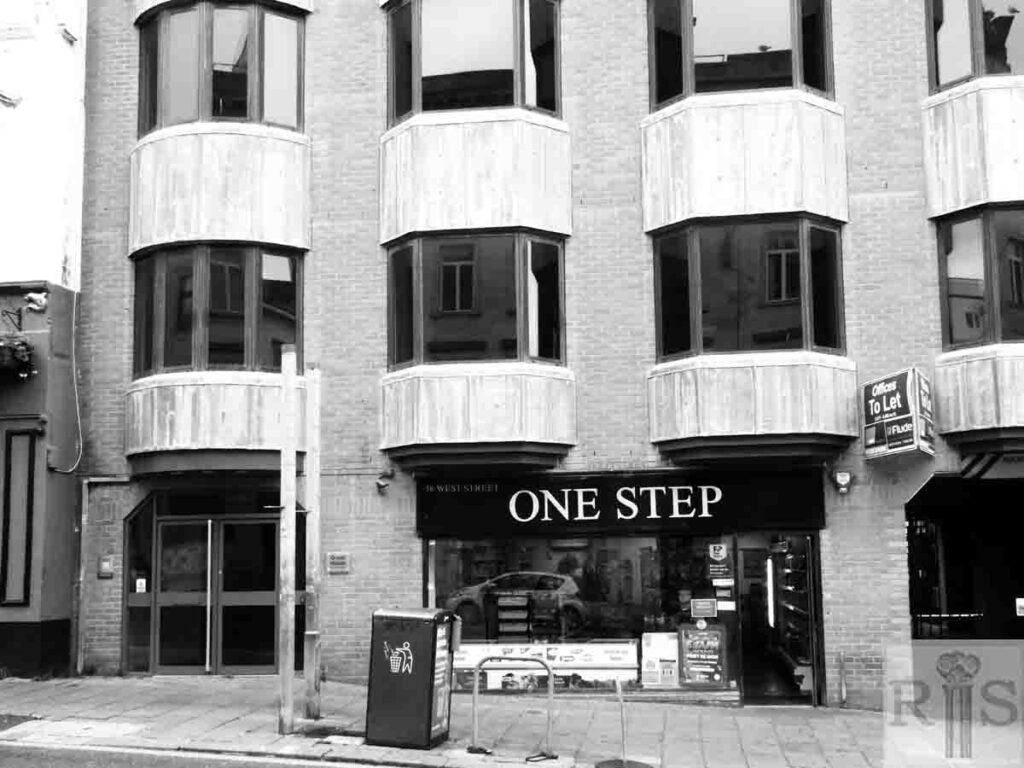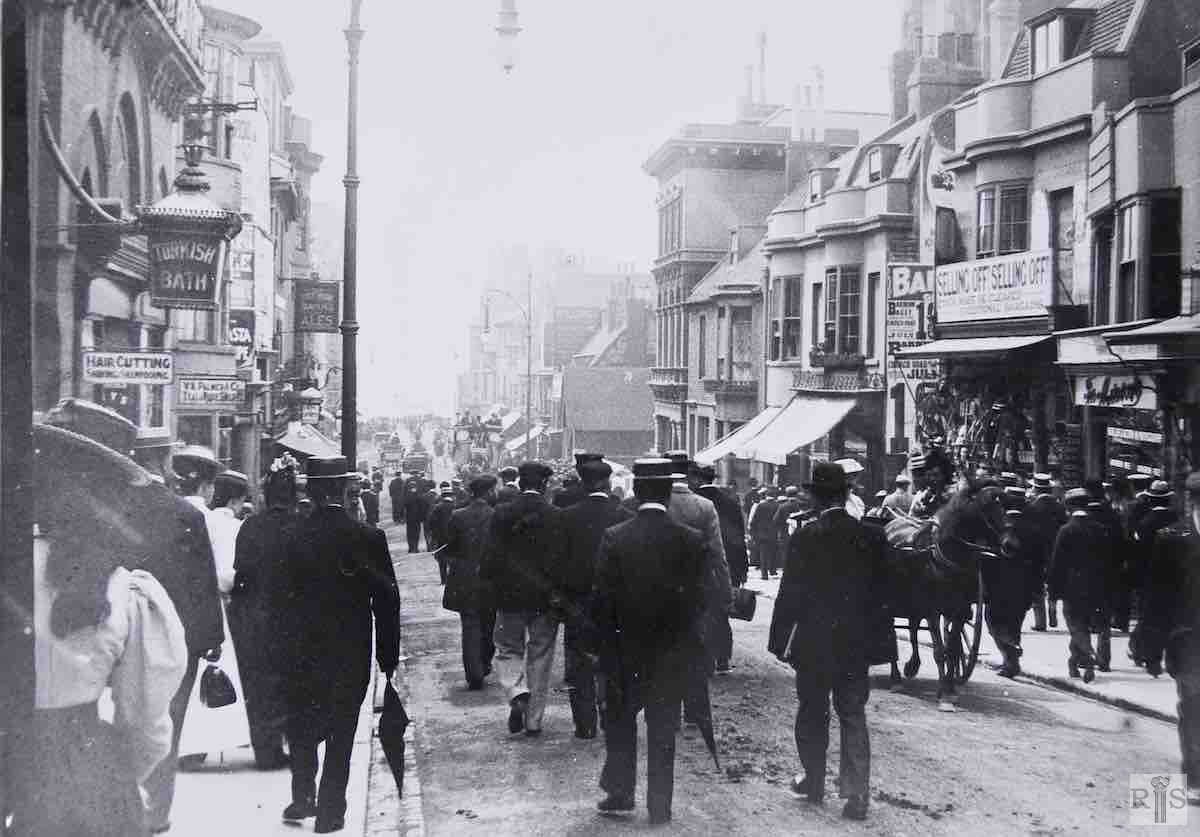
between Regency Road and North Street
James Gray: Another of the narrow courts which existed on the west side of West Street. This was approached by a narrow alley between 31 and 32 West Street, adjoining the famous Sausage, Potato and Onion Restaurant of William Harris. Ten small cottages were still habited when the end came in 1933. A photograph showing this court being demolished can be seen on another page. jgc_07_053
2019: As James Gray states, this court was demolished in 1933 as part of the road widening scheme. The area where these cottages were sited is now occupied by Phoenix House, which was built in the 1930s and backs onto Upper Russell Street. (Photographer: Clare Hughes)
James Gray: The holiday crowd stream down West Street on a Sunday in July 1899. This is the only one of my many photographs of Old West Street that shows even a glimpse of the Turkish bath. This was built on the site of private houses, in 1868, at a cost of £14000 and remained until 1911 when it was removed to make way for the Academy Cinema. This by the way, was the first cinema in Brighton to be built especially for that purpose. jgc_07_054
James Gray: A narrow, shabby street of small shops and eating houses, amusement arcades and mock auction rooms. Narrow courts of ancient houses led from both sides of the street, Bunkers Hill, Chuters Gardens and West Street Cottages on the west, and Willow Cottages on the east. No buses used the street. The tower of St Paul’s Church, which then stood well back from the street, is hidden from view. jgc_07_057
2019: This view of West Street shows how radically it has changed since the 1930 photograph was taken. The street was widened in the 1930s and many of the buildings on the west side were demolished.
James Gray: Over the course of 25 years, the ramshackle buildings shown on the previous page had been replaced. Shortly before the date of this photograph North Street had been widened on the north side by the White Lion Hotel. The rounded corner building was demolished in 1926. jgc_21_003
2018: The road layout is still roughly the same. The old rounded building that housed ‘George Bull Grocer and Tea Dealer’ has been replaced and on the site today is a branch of Waterstones bookshop.
James Gray: This is a drawing of old houses at the corner of Duke Street & West Street, about 1870. These buildings were all owned by Mr Trill who occupied 22 Duke Street, as a printing works, No 23 as a baby linen warehouse, while at No 54 West Street, he was in business as a ladies outfitter and stay manufacturer. Additional Information: One of three photos on page. jgc_08_019
James Gray: A much later photograph [than possibly jgc_07 131 on the North Street (Brighton) (1) page] of 1955 showing two bottlenecks which hindered the somewhat limited traffic of that period. At the bottom, old buildings below the Sports Stadium and, at the top, the side of the men’s conveniences, which stuck out beyond the West Street building line. Otherwise not much visible sign of change from today [1970s?]. jgc_07_063
2020: This image shows that the men’s conveniences at the top of West Street have gone and the road is now wider and in keeping with the building line. Other buildings to the north of West Street remain largely unchanged with a Mexican restaurant now occupying part of the ground floor of Bostel House on the corner of West Street and Cranbourne Street. (Photographer: Clare Hughes)
James Gray: View from the Clock Tower down the narrow West Street. This gives a good view of Baker’s Cloth Hall. These premises were demolished later in the year and replaced by the Burton building set back to the new building line. It is interesting to note that the No 7 bus then travelled down West Street. jgc_07_066
2020: This remains a busy spot in Brighton. The Burton building now houses Waterstones booksellers and is set back from the road. Some of the buildings on the eastern side of the street remain but the graffiti is only present in the 2020 image! The No 7 bus still runs but goes down North Street rather than West Street. (Photographer: Clare Hughes)
James Gray: For many years the premises at the junction of West Street and North Street were occupied by J Baker and Co. Ltd., Outfitters, and were known as Baker’s Cloth Hall. In 1925 they were demolished and a new building was begun, built out to the original line of frontage. At this period the widening of West Street had not been decided upon. This new building got so far and then work stopped for about two years. During this time the site was hidden behind this huge, ugly hoarding which excited much adverse comment. The Corporation then decided to widen West Street on its west side with the result that, when Burton’s new building was erected in 1928, it stood well back from the original West Street frontage.
James Gray: Old houses, Nos 34-37 West Street, in 1930, prior to demolition. At this period the only widening was above Cranbourne Street. jgc_07_070
2020: This image shows the premises that are the current 34-37 West Street. Office Angels is an employment agency. Raft was a contemporary furniture shop that closed down in 2019. (Photographer: Clare Hughes)
James Gray: April 1931. Demolition has now extended to Cranbourne Street to No 31, and the road widened in front of the clearance sites. Additional Information: Advertising billboards: Guinness, Andrews, St Julien, Savoy Cinema, The London Palladium, Bovril. jgc_07_071
James Gray: The central section of West Street undergoing reconstruction. The Phoenix building at No 32 is shortly to be erected. Meanwhile the cleared site affords a glimpse of the old tabernacle exactly 100 years old, hitherto completely hidden behind the shabby buildings of the old street. Lower down, the street has been almost doubled in width and the side wall of the newly built Sports Stadium is just visible below the church. Additional Information: Harris; Guinness; National Benzole; BP for anti-knock. jgc_07_100
James Gray: Buildings at the corner of West Street and Cranbourne Street shortly before their demolition. At this time, the only rebuilding and street widening was between the north side of Cranbourne Street and the Clock Tower. jgc_07_073
2020: The buildings in the 1930 image were all demolished as part of the West Street widening initiative. Bostel House was built on the site and is still a prominent feature of West Street. It houses offices, and has shops and restaurants on its ground floor. (Photographer: Clare Hughes)
James Gray: Turpins premises at 51 West Street, directly opposite the premises shown in the previous photograph ([jgc_07_074]. Period not known, but it must have been between 1924 and 1932. jgc_07_075
2020: There is now a branch of the TSB (Trustee Savings Bank) at 51-53 West Street.The buildings in the early James Gray photograph have long disappeared. (Photographer: Clare Hughes)
James Gray: Demolition of 35, 36 and 37 West Street in progress, April 1930. jgc_07_076
2020: Bostel House is now on the site where the demolition was taking place in 1930. Nos 35-37 are shown in the 2020 image. Raft was a contemporary furniture store that closed in 2019 and next door is a noodle bar. (Photographer: Clare Hughes)
James Gray: 17 August 1930 8.15 a.m.
1/6 One of the first large buildings erected on the newly widened West Street was Bostel House, at the corner of Cranbourne Street. These six snapshot photographs [jgc_07_077 to 082] show the work in progress during 1930 and 1931. jgc_07_077
2020: See caption for jgc_09_076 above. (Photographer: Ron Fitton)
James Gray: The building shown in the previous photograph [jgc_07_073 above], Nos 35-37 West Street and 1 and 2 Cranbourne Street, has been demolished, and the cleared site is ready for the erection of Bostel House. This photograph shows the extreme narrowness of the street at this period. jgc_07_074
2020: West Street was widened between 1928 and 1938 and many of the buildings on the western side of the street demolished. The 1930 image illustrates some aspects of this process. Bostel House is still a prominent feature of West Street. It houses offices with shops and restaurants on its ground floor. (Photographer: Clare Hughes)
James Gray: 17 September 1930. One of the first large buildings erected in the newly widened West Street was Bostel House, at the corner of Cranbourne Street. These six snapshot photographs [jgc_07_77 to 082] show the work in progress during 1930 and 1931. jgc_07_079
James Gray: 4 April 1931. [See caption for jgc_07_079 above.] jgc_07_082
James Gray: Bostel House, at the corner of Cranbourne Street, newly built in 1931. At the extreme left a glimpse of the cottages of Bunkers Hill. jgc_07_090
2020: Bostel House is still a prominent feature of West Street. It houses offices, and has shops and restaurants on its ground floor. (Photographer: Clare Hughes)
James Gray: A view of old West Street in 1934 showing Harris’s S. P. and O, Steak House. This is almost identical to a photograph on another page, [jgc_07_095] though obtained from different sources. jgc_07_109
James Gray: Brighton Turkish Baths, 59 West Street. Advertising. jgc_07_056
James Gray: The Academy Cinema, West Street, photographed on 22 October 1972. Built in 1912 on the site of the Turkish Baths (1868–1911) it was then the largest of Brighton’s few cinemas until dwarfed by the Regent, opened in July 1921. It was the second cinema to be converted to talking pictures, on 14 October 1929. After a long life of more than 60 years it closed on 24 January 1973 and it was demolished during April and May in that year, to be replaced by yet more offices. jgc_07_119
2019: After demolition in 1974, a new building named Academy House was built on the site at 59 West Street. The ground floor was occupied by Yates Bar for many years. It is currently trading as the late night venue Popworld, part of the Stonegate Group. (Photographer: Denise Taylor)
James Gray: The street decorated in May 1935, for the George Vth Jubilee Celebrations. All the buildings on the left below Cranbourne Street had been built in the previous four years. jgc_07_085
James Gray: These photographs, showing the top of West Street east side, were taken about 1960. The Eight Bells public house, although not one of Brighton’s oldest inns, had been here for more than a century, but is now gone. The tall building facing into West Street was the White Lion Hotel, the ground floor being occupied by Barclays Bank. It had been reconstructed and set back in 1874, the date being inscribed on the pediment. The bank vacated their offices in 1957 but the building remained for another twenty years, being demolished in 1977 and replaced by the present Boots store. jgc_07_089
James Gray: 51/2/3 West Street, at the corner of Duke Street, in April 1963. The corner building was erected in 1867 after widening of the north side of Duke Street. All demolished and replaced by Guardian Assurance Company building in 1964. jgc_07_093
2021: The later building has been home to a number of financial institutions since it was built but is currently closed and boarded up. (Photographer: Ron Fitton)
James Gray: This is a very clear photograph of one of the old West Street private houses, taken on 25 March 1984, when demolition was already threatened. During its long life, exact length unknown, its most prominent occupant was Alderman S H Soper, Mayor of Brighton in 1890, who founded his drapery Emporium at 78-83 North Street in 1860. He lived in this house from about 1870 well into the 1900s, after which it became an annex to his nearby store. Later it was made into these three small shops with offices above. Demolished in 1986. So passes from the scene another part of “Old Brighton”. jgc_07_121
2021: Replacing 58 West Street in 1987, Ovest House is a 5-storey, purpose-built office block with the One Step convenience store and an entrance to parking spaces on the ground floor. On the far left, there is just a glimpse of Molly Malone’s, an Irish pub which reopened in 2022 after losing its licence for 10 months. (Photographer: Ron Fitton)
